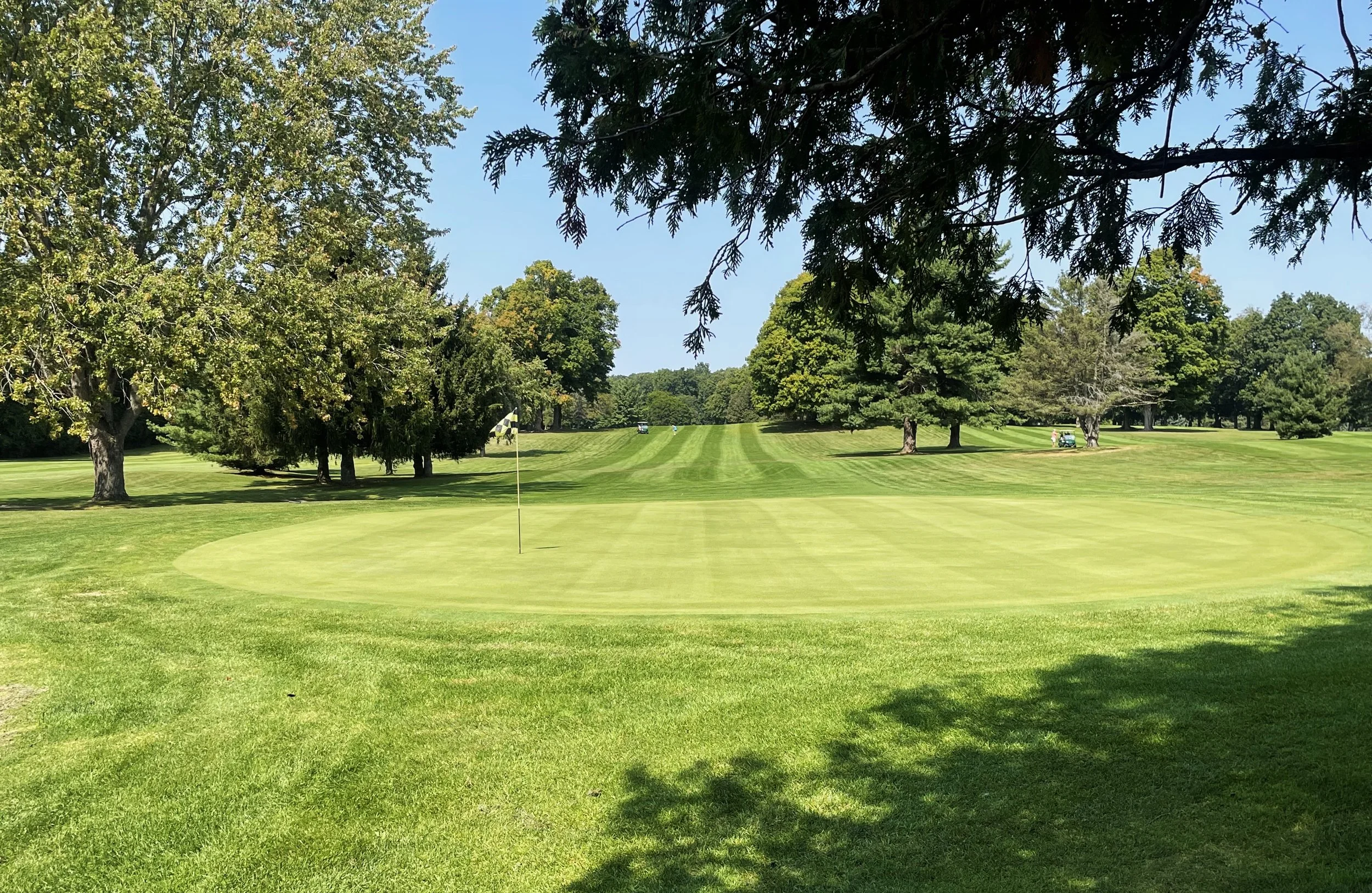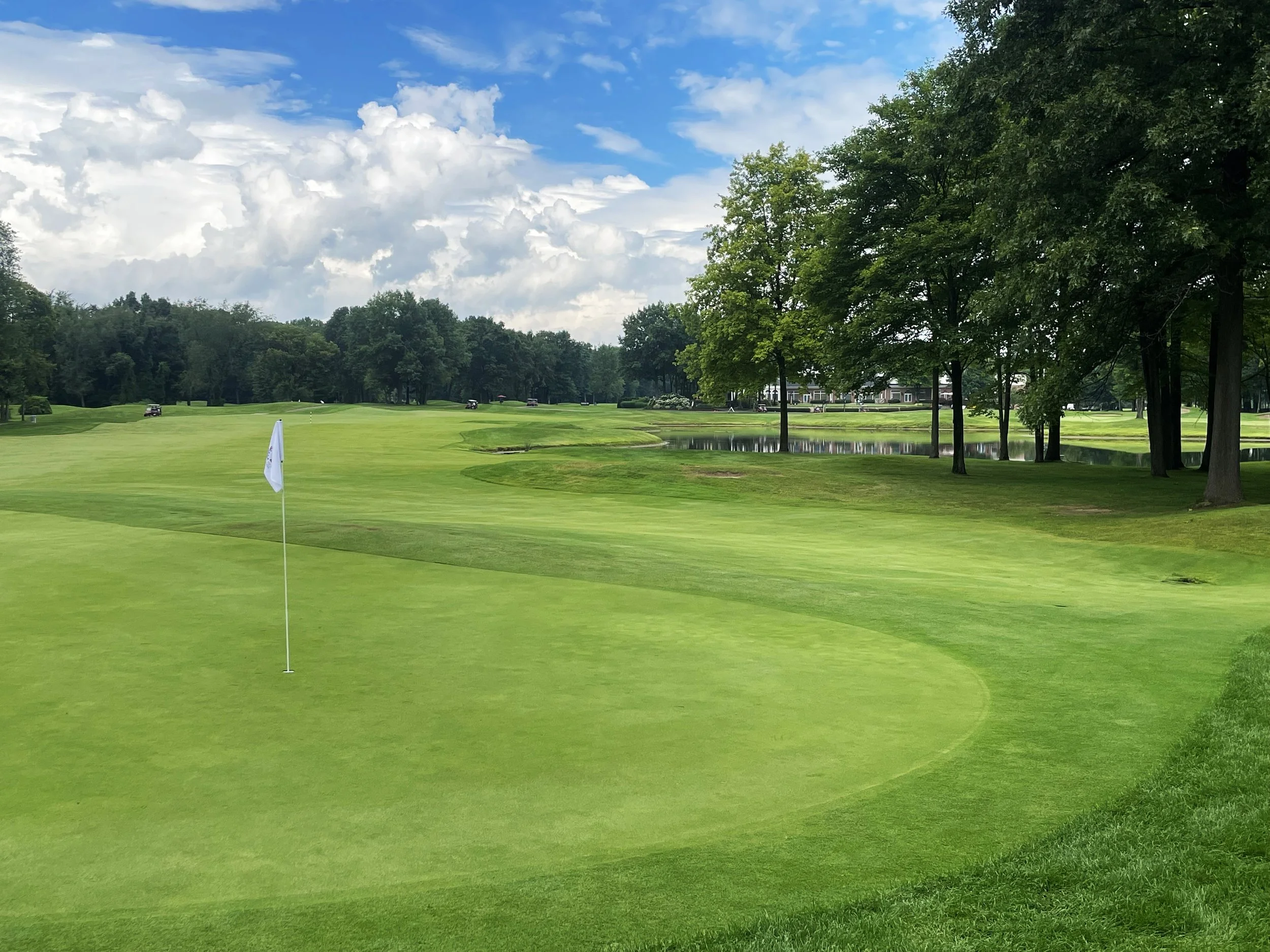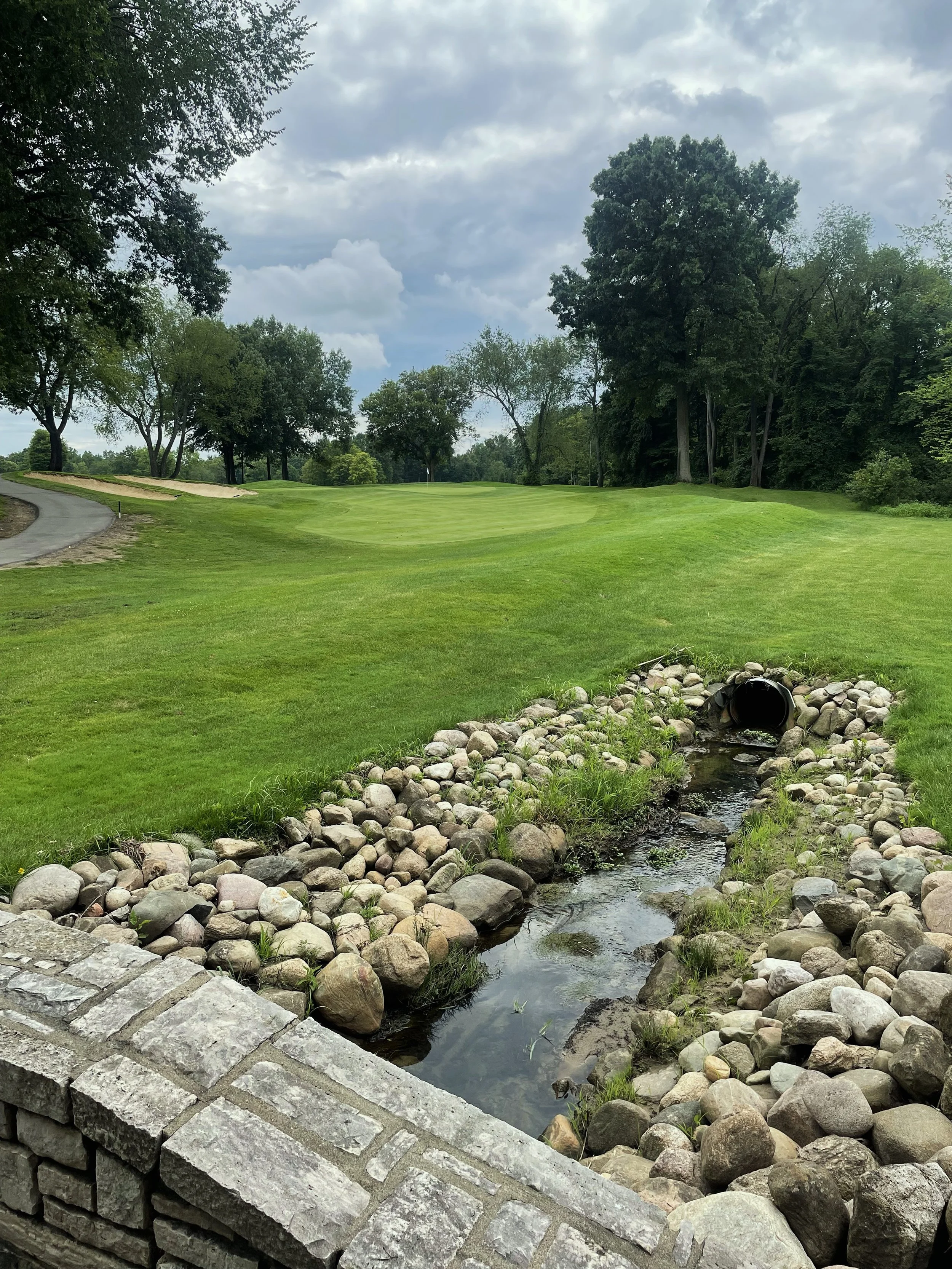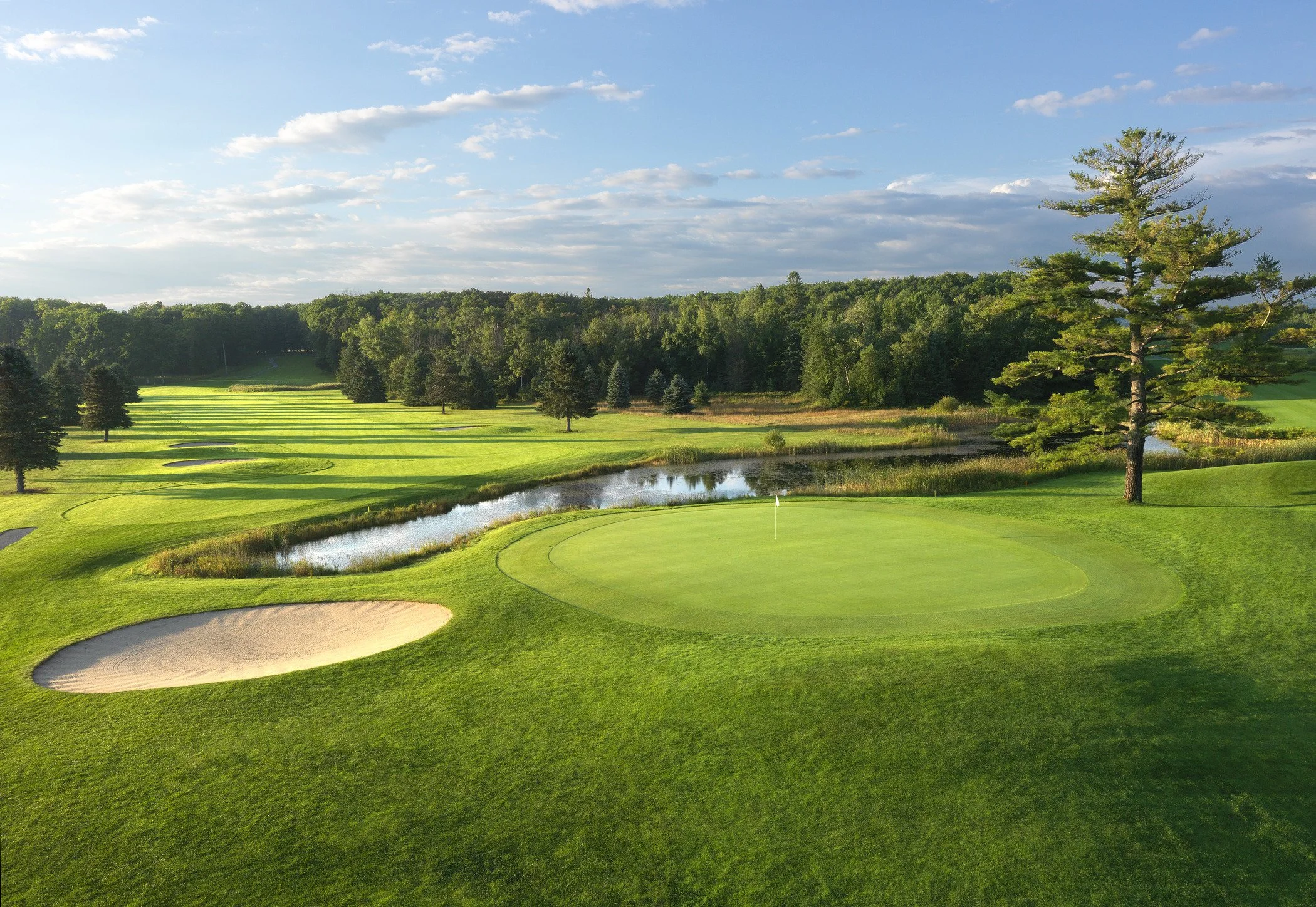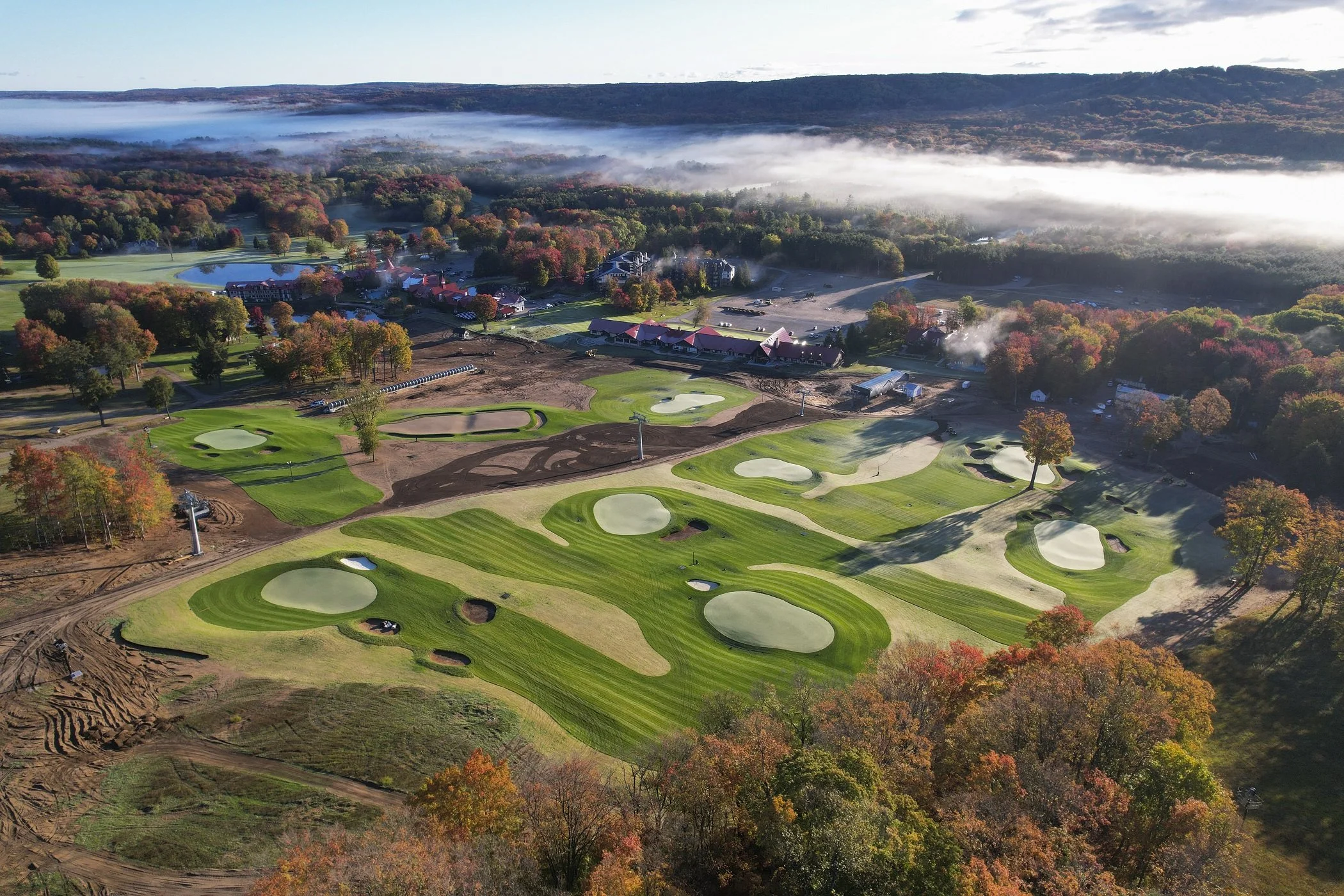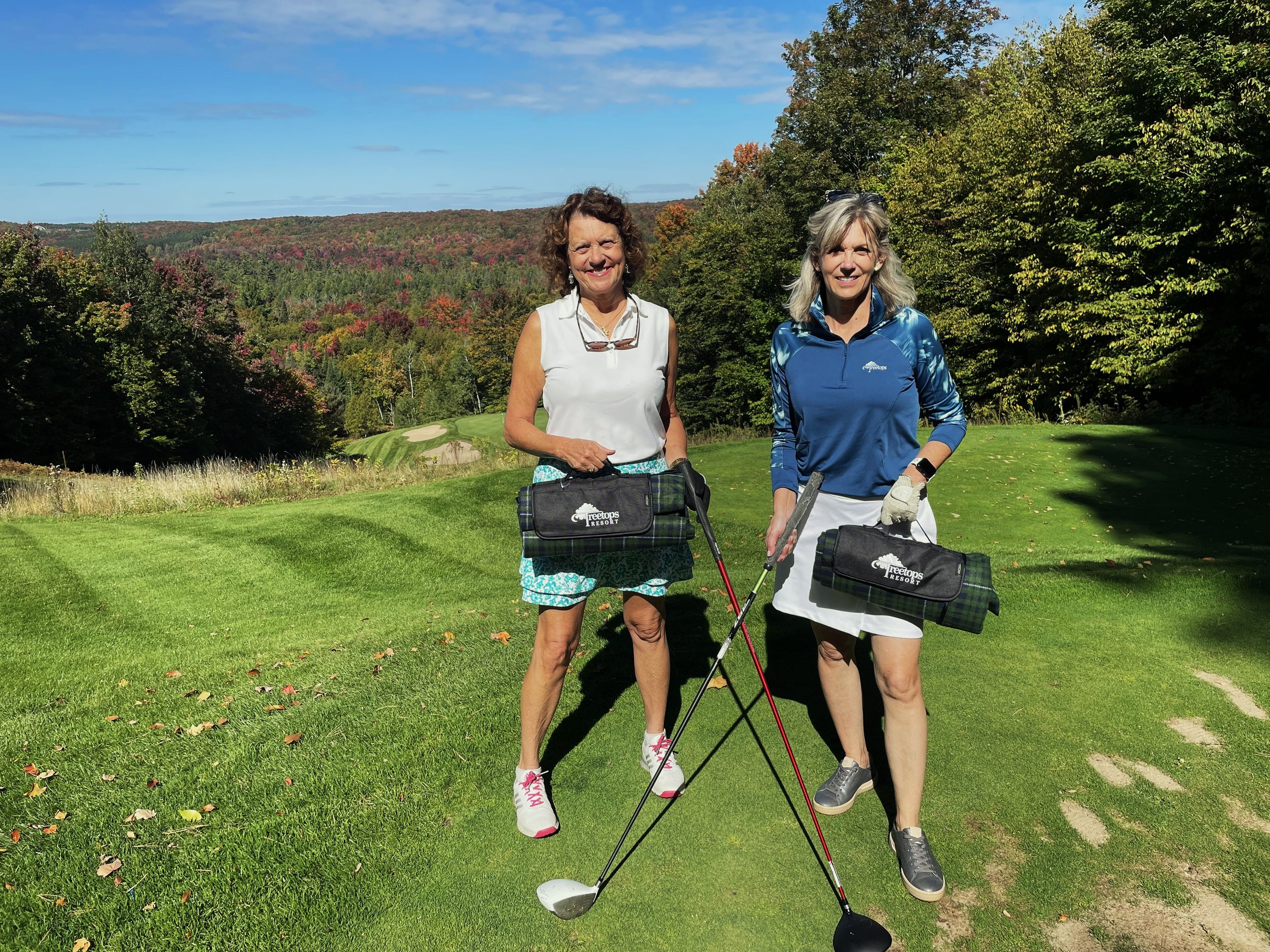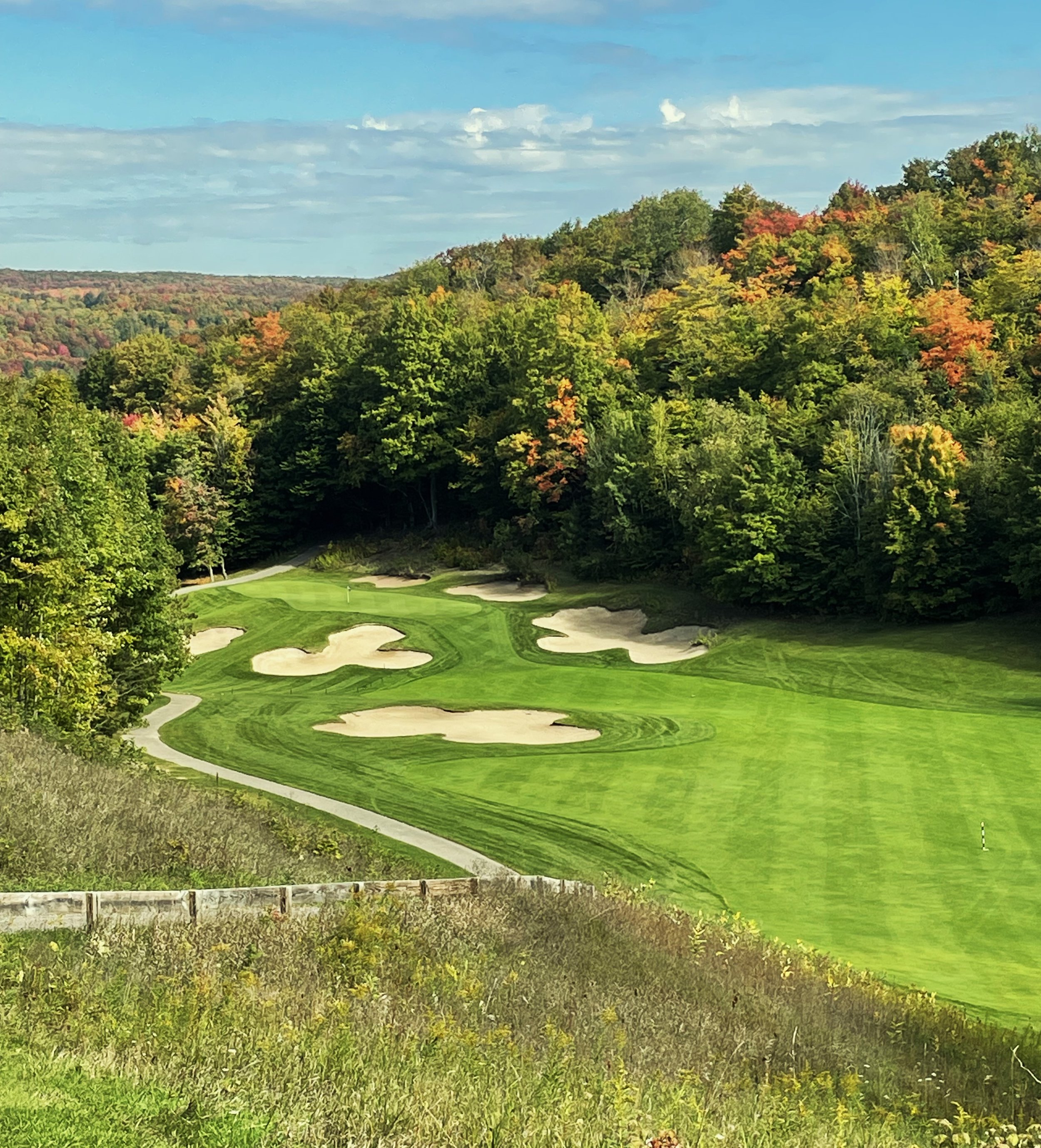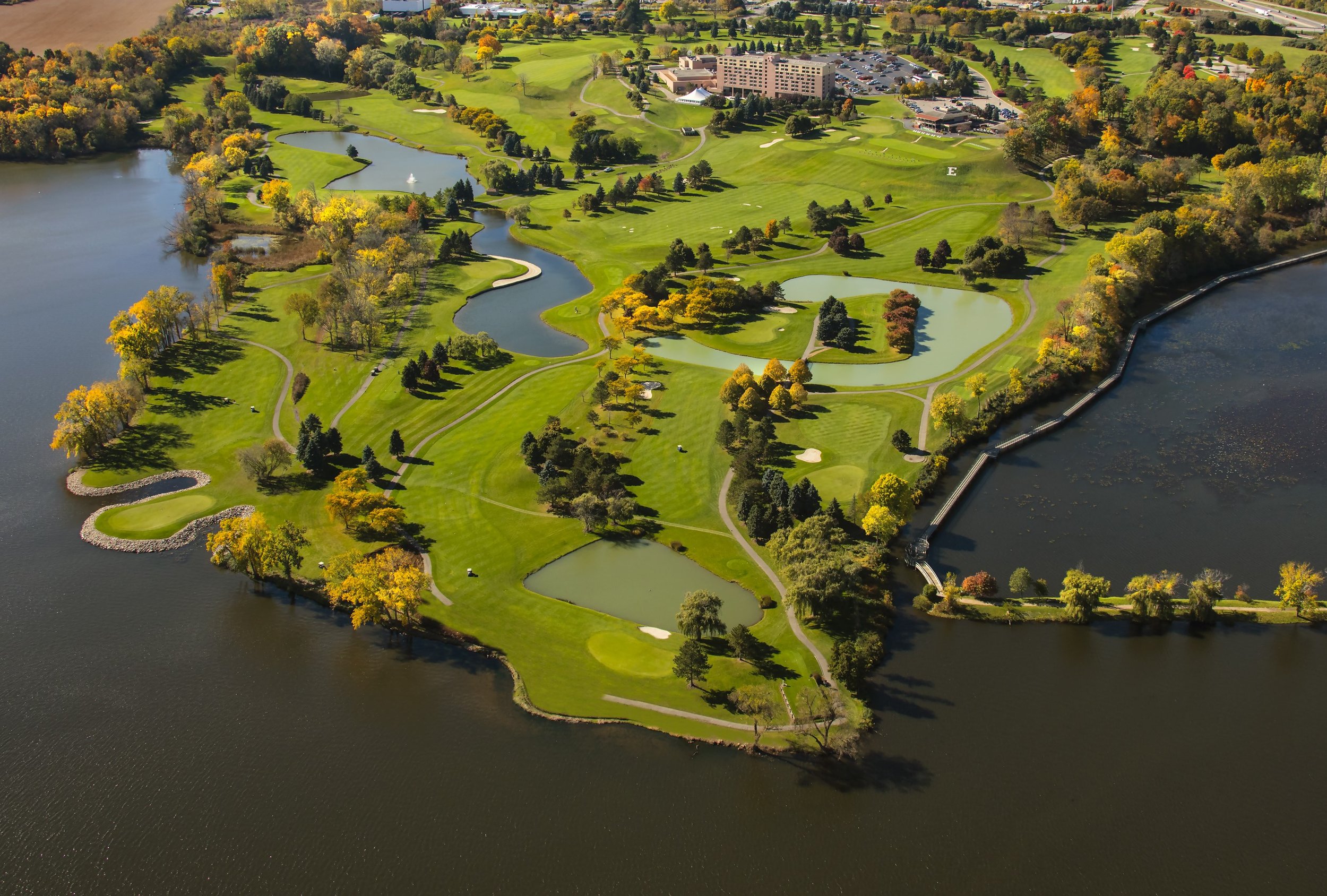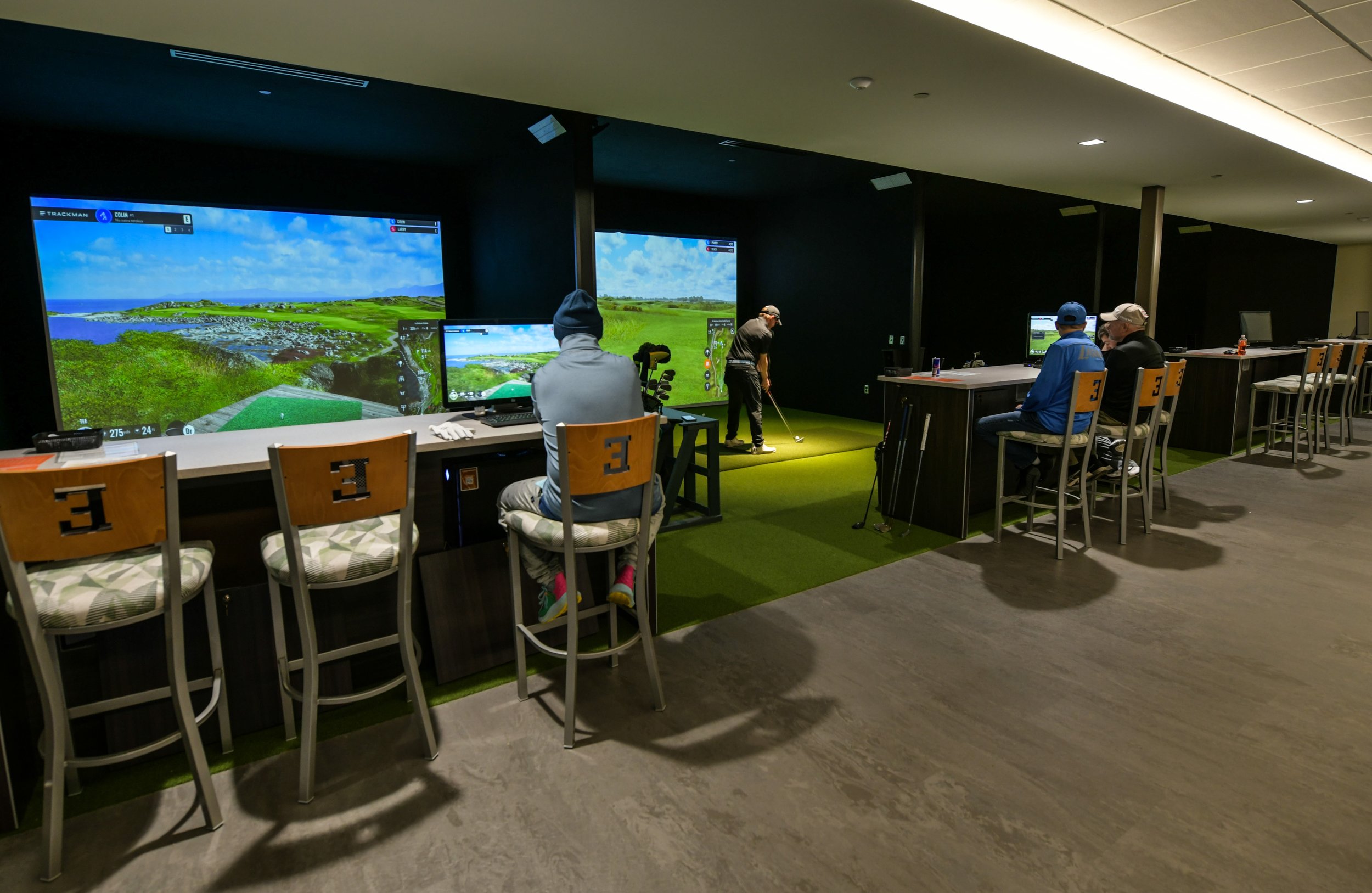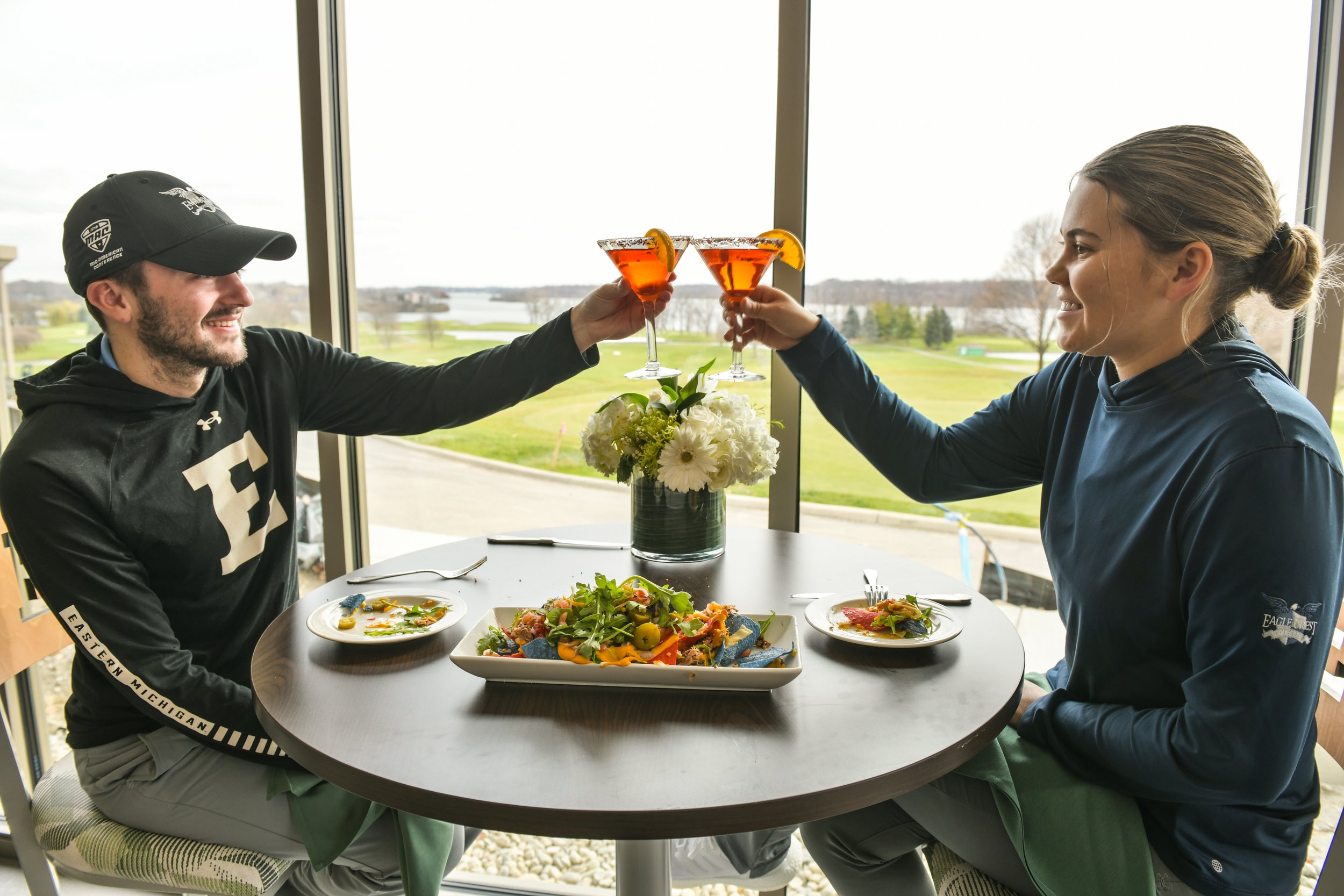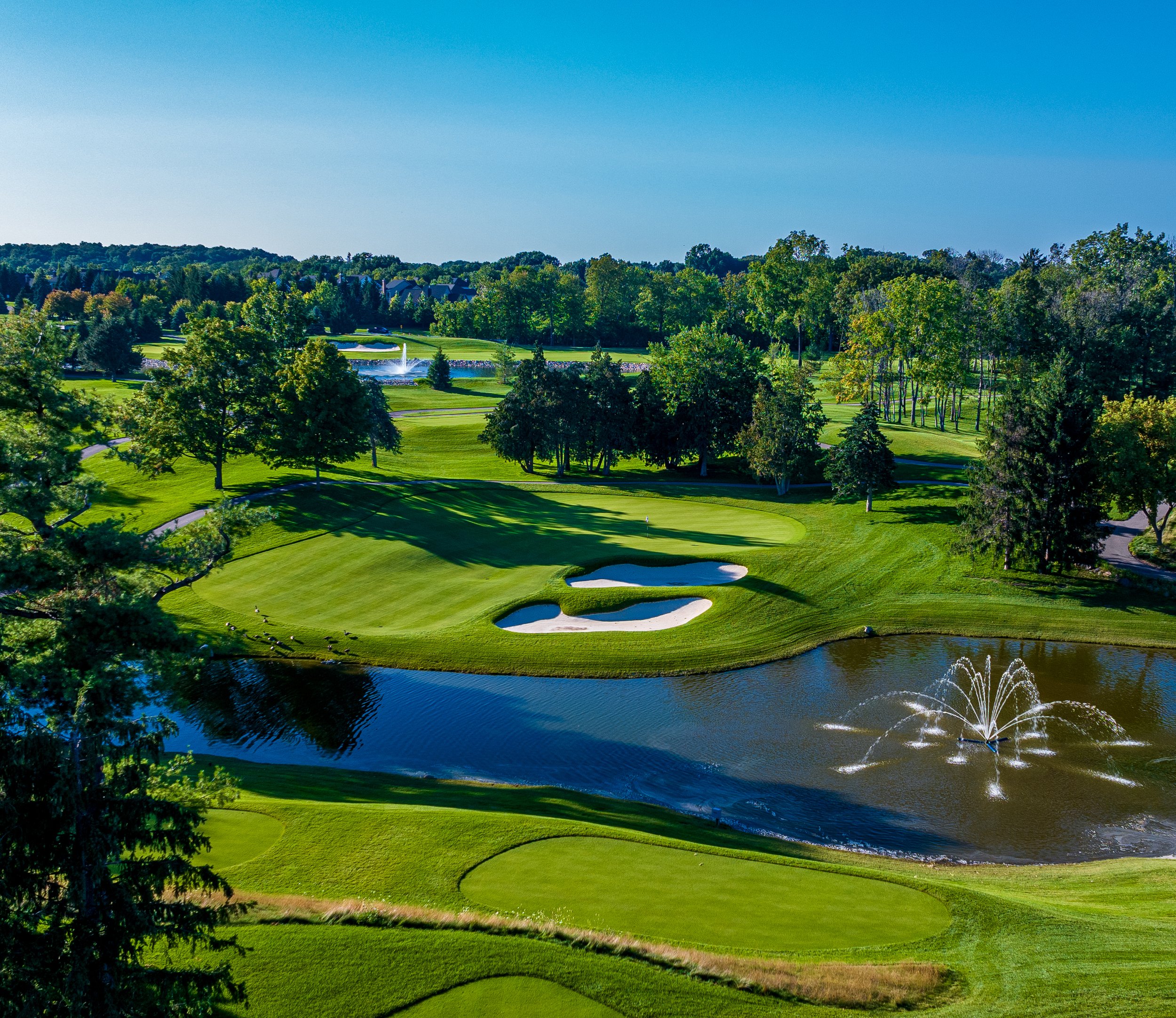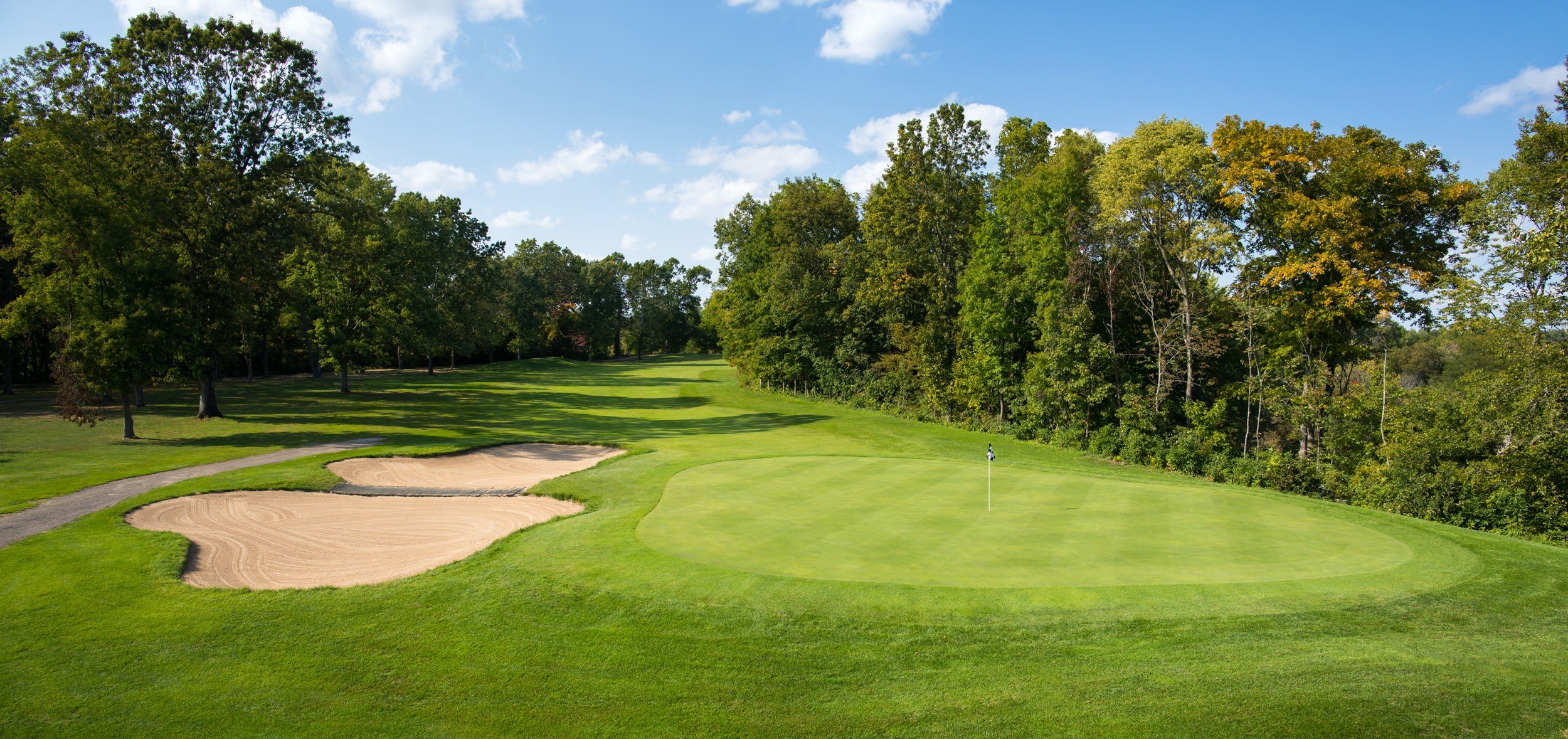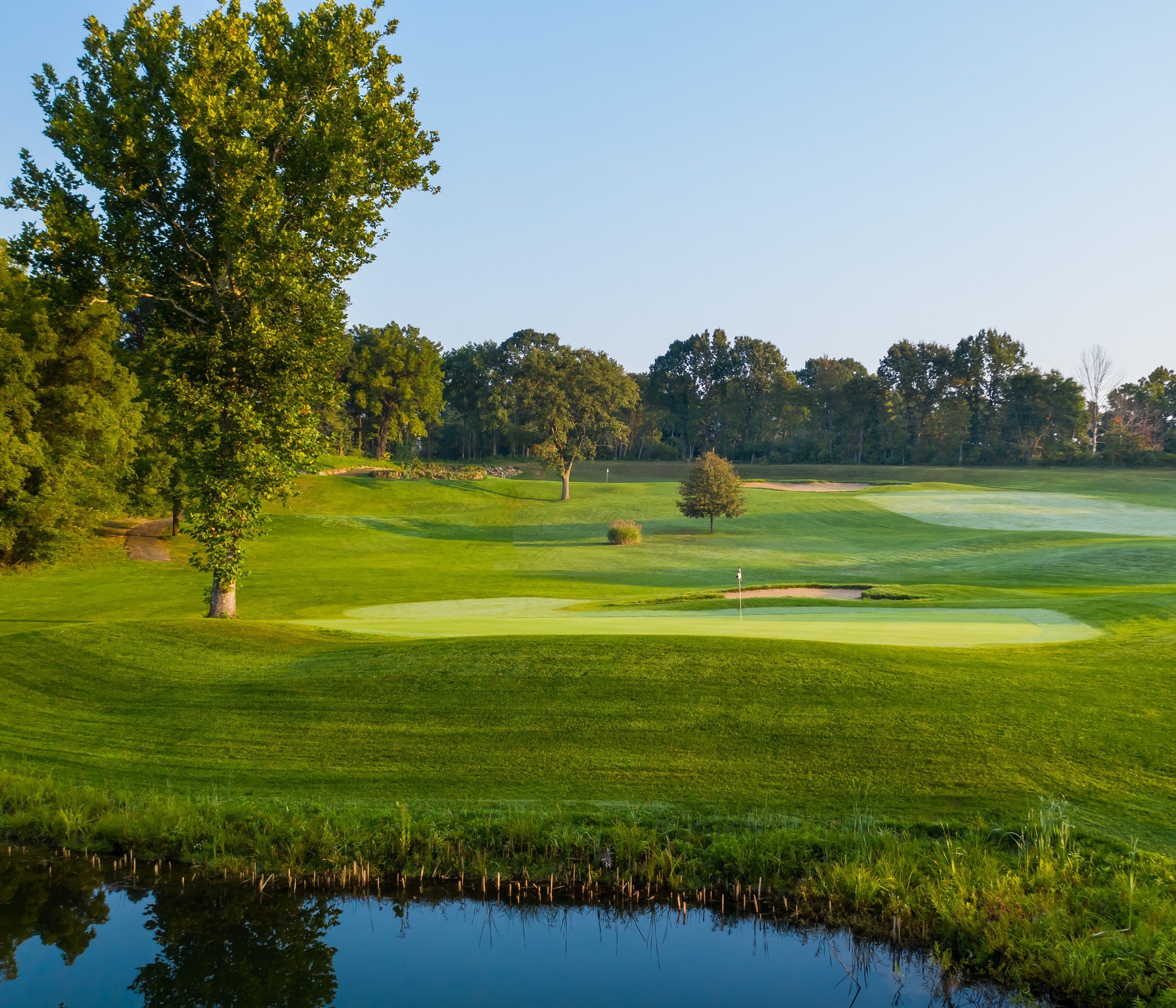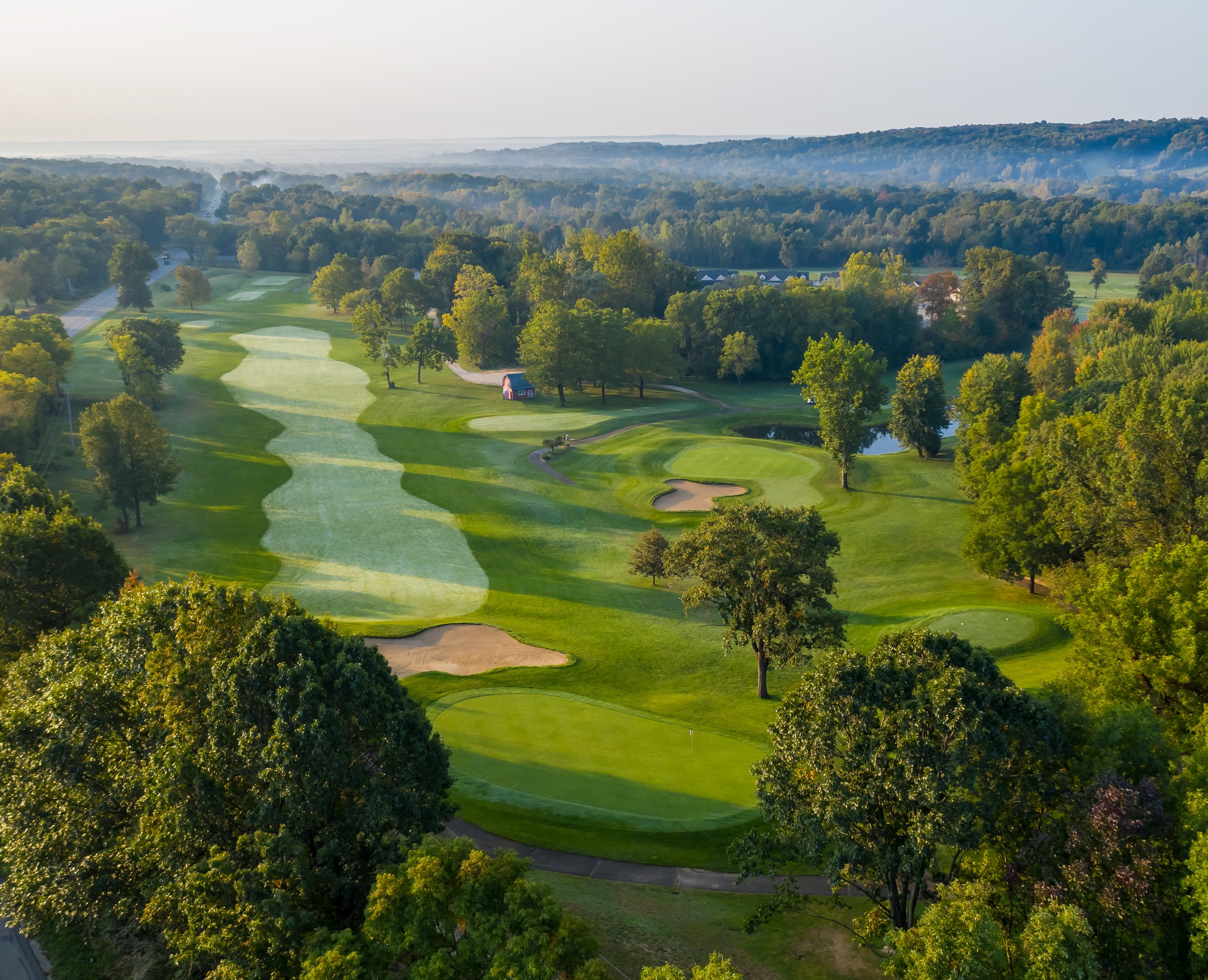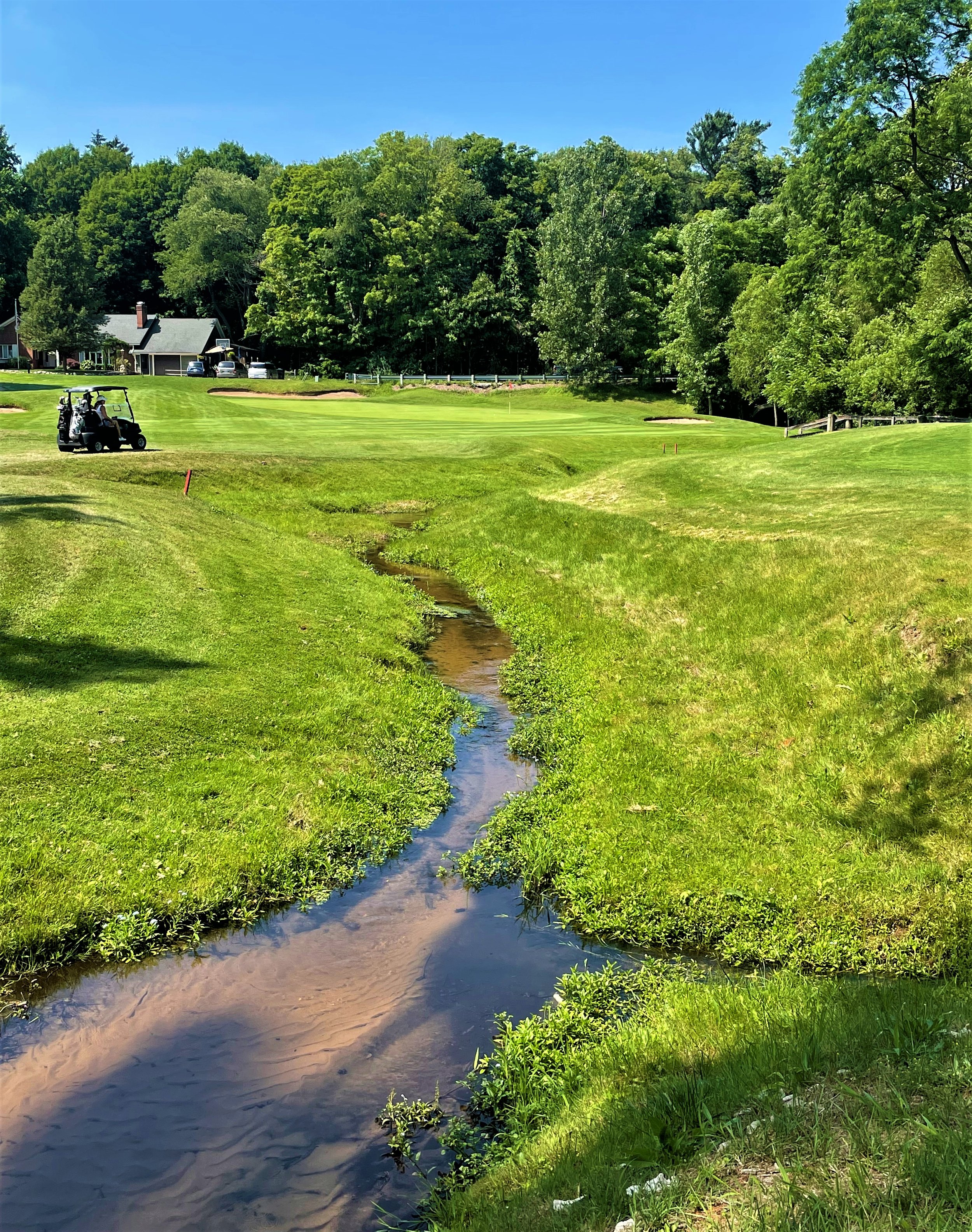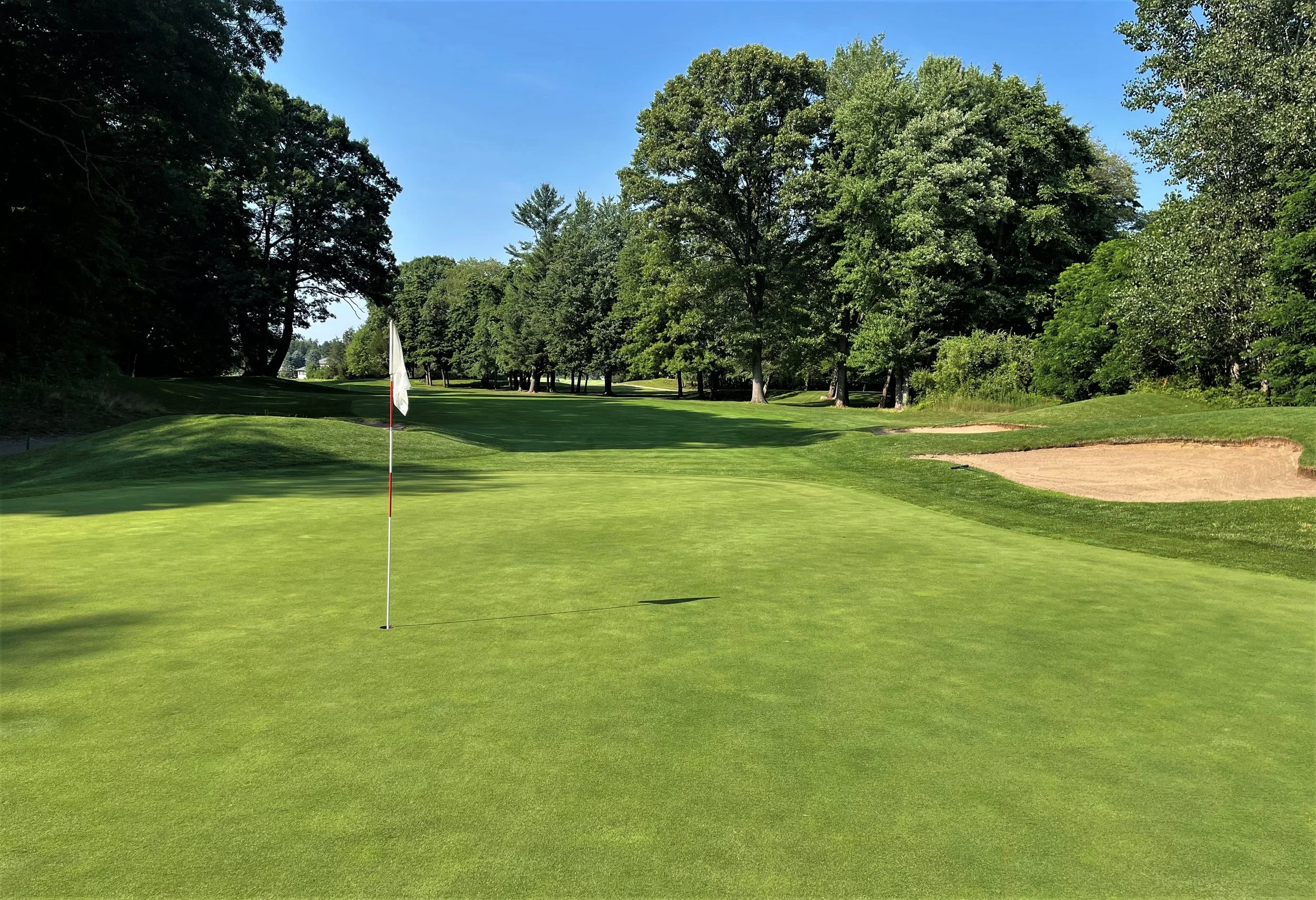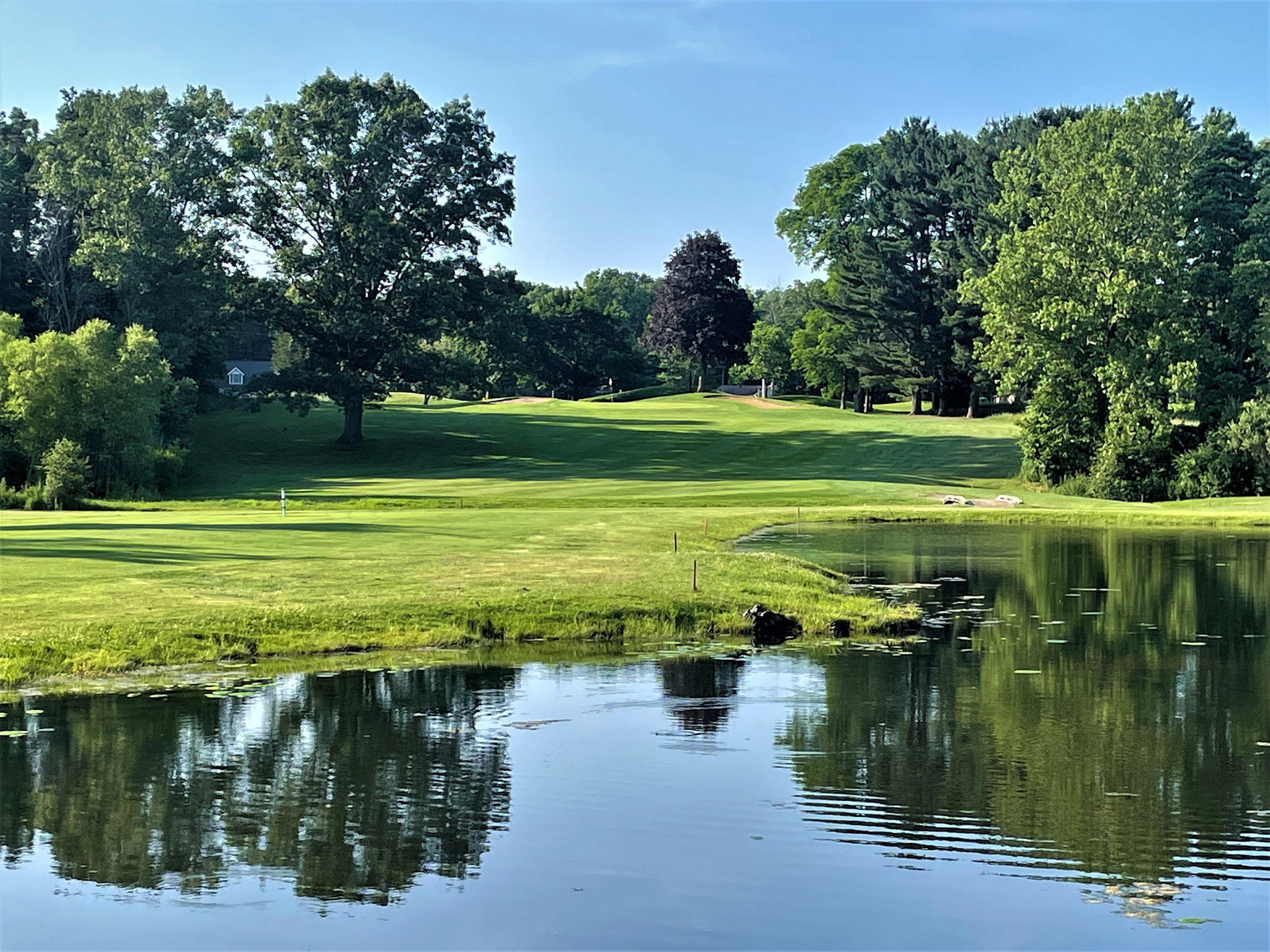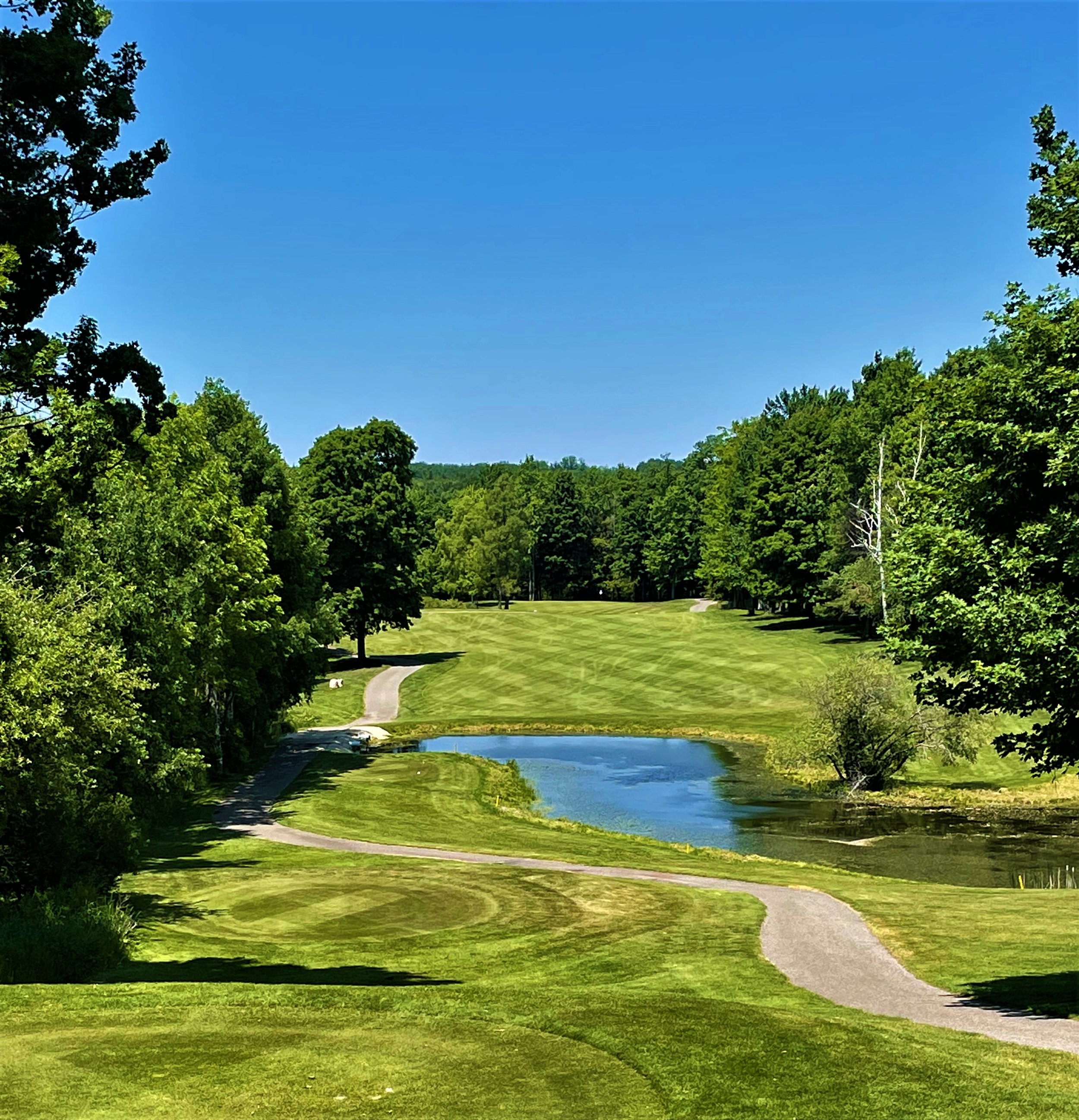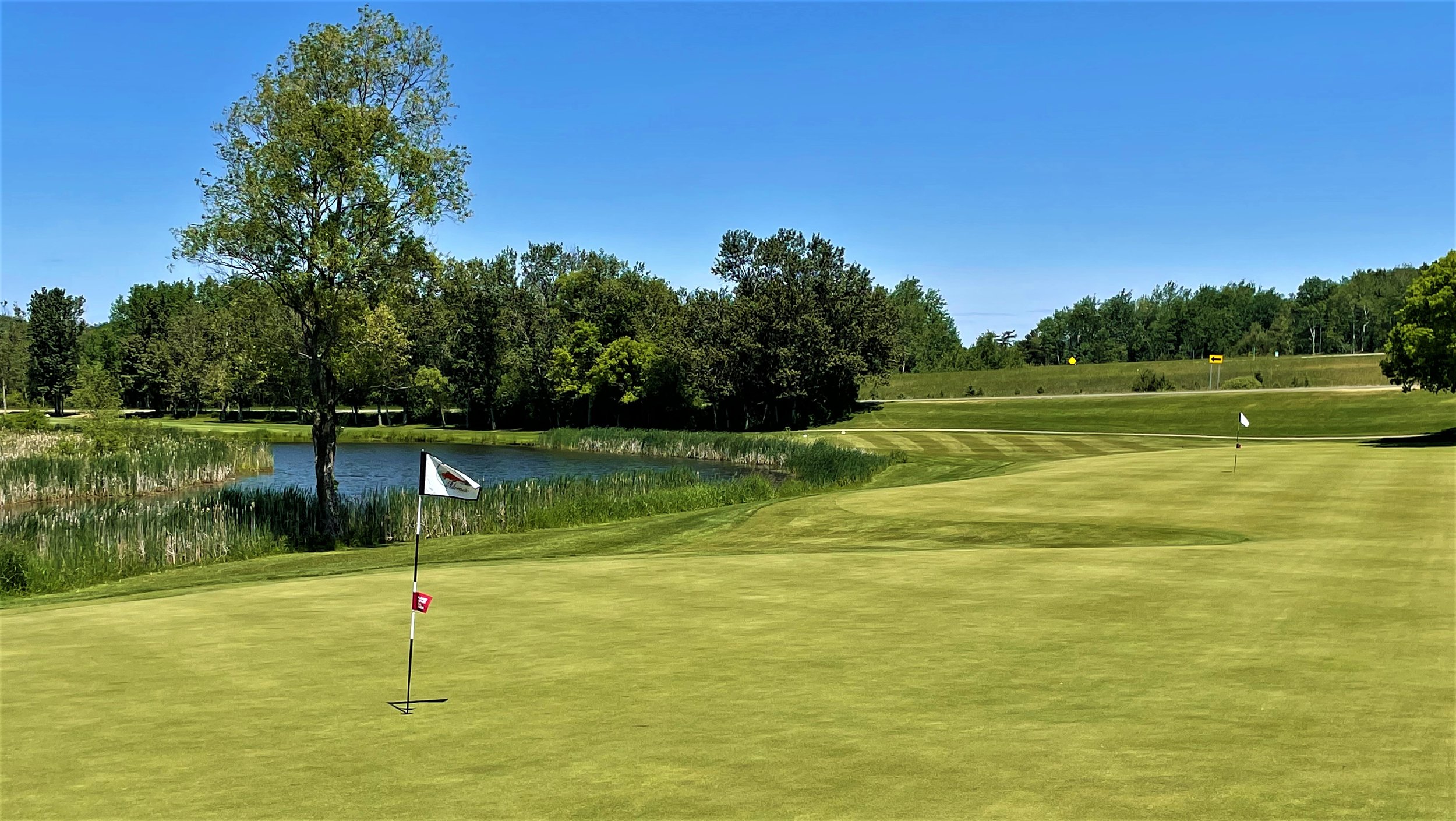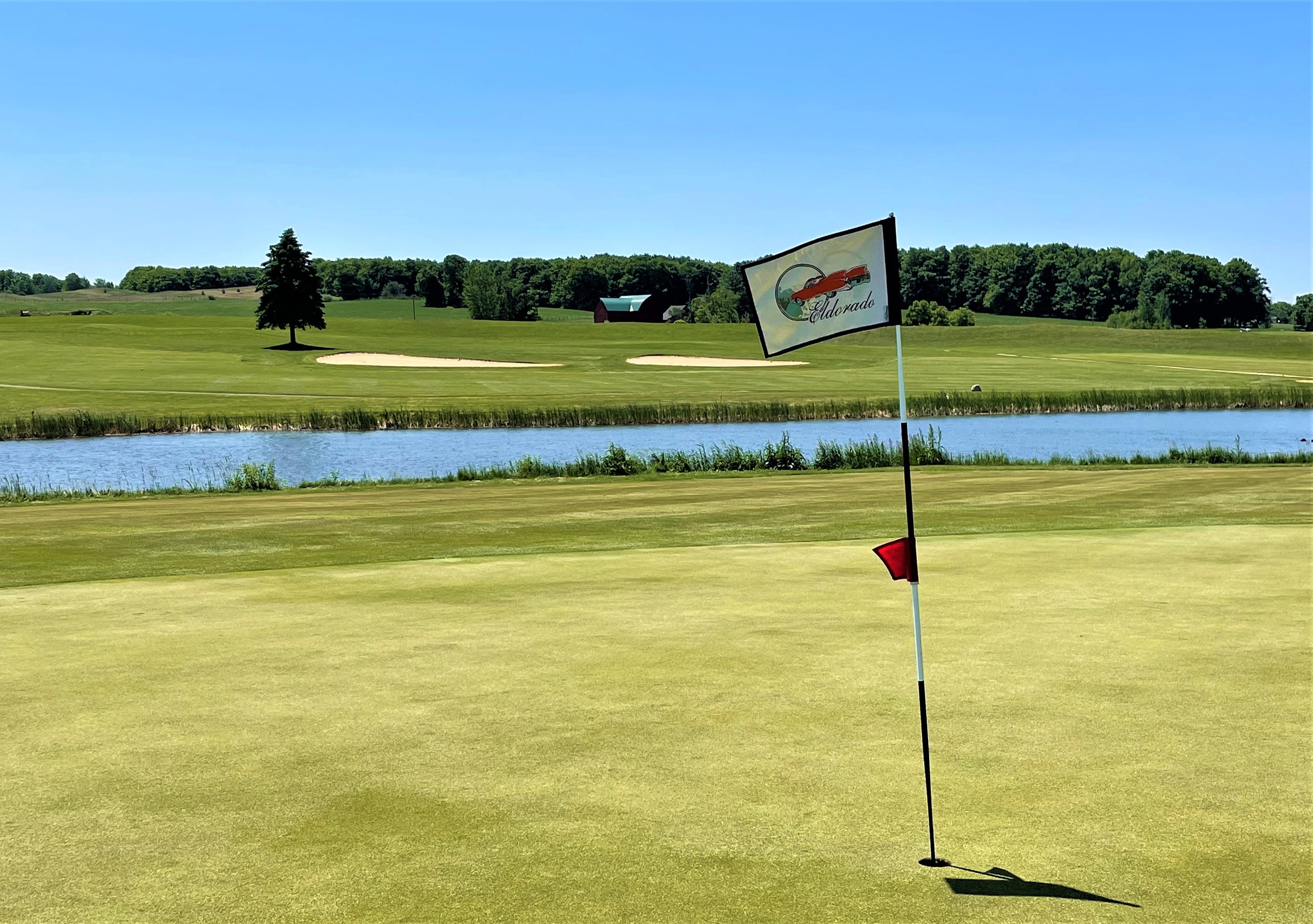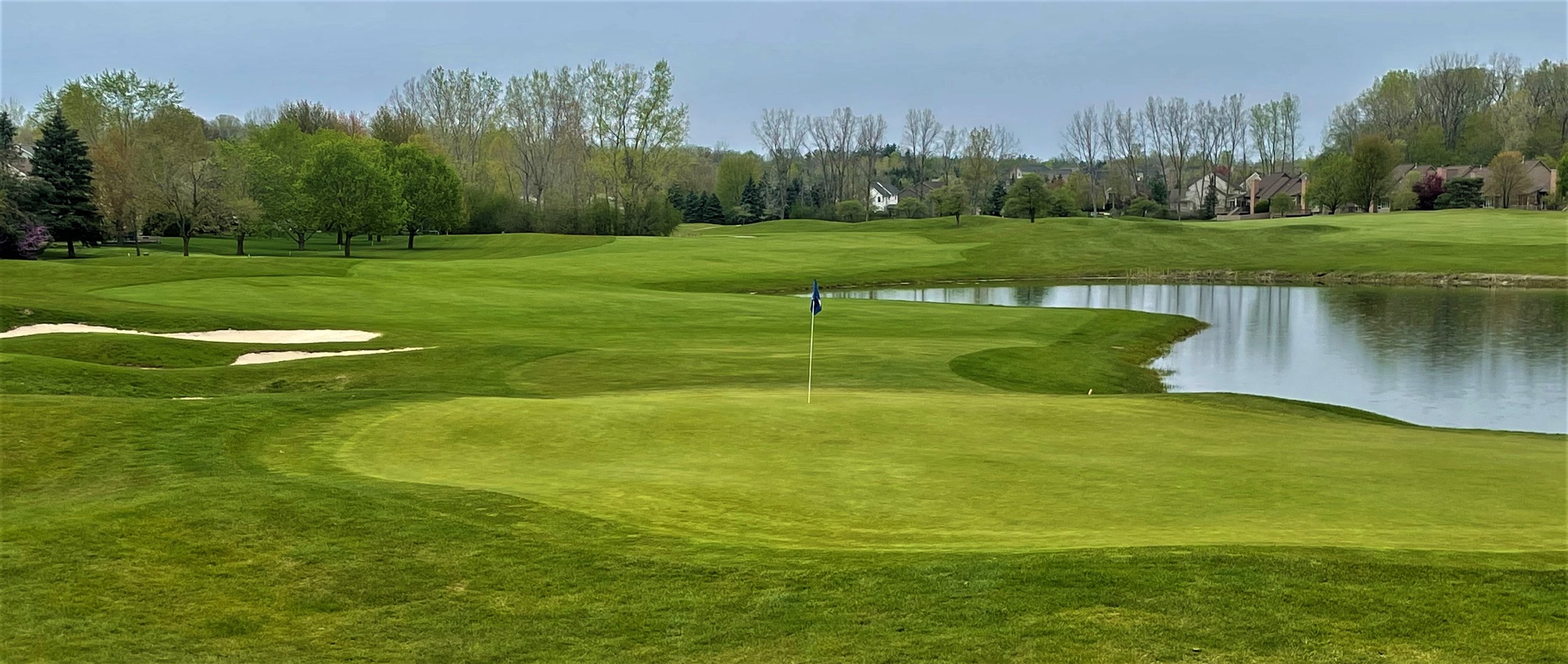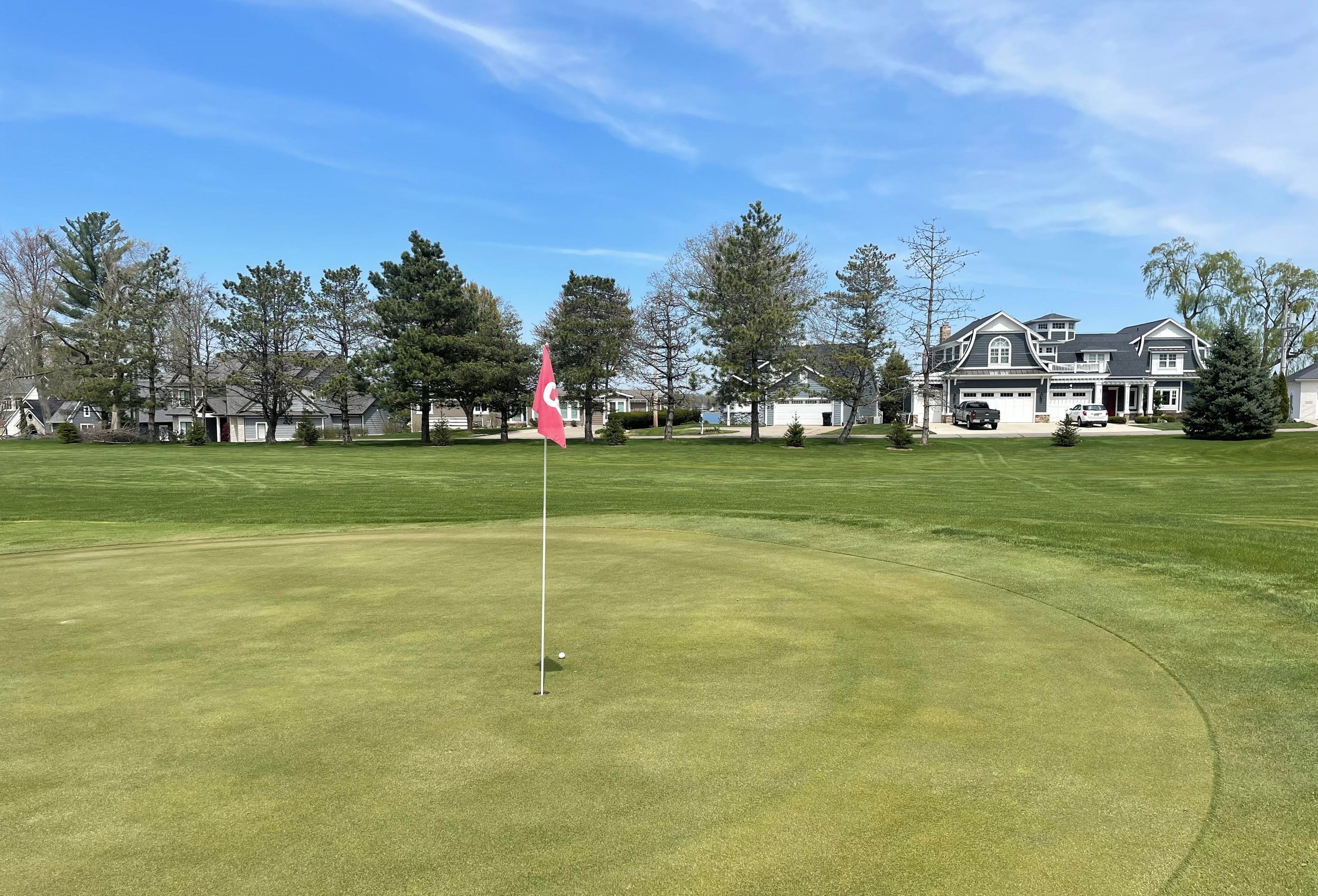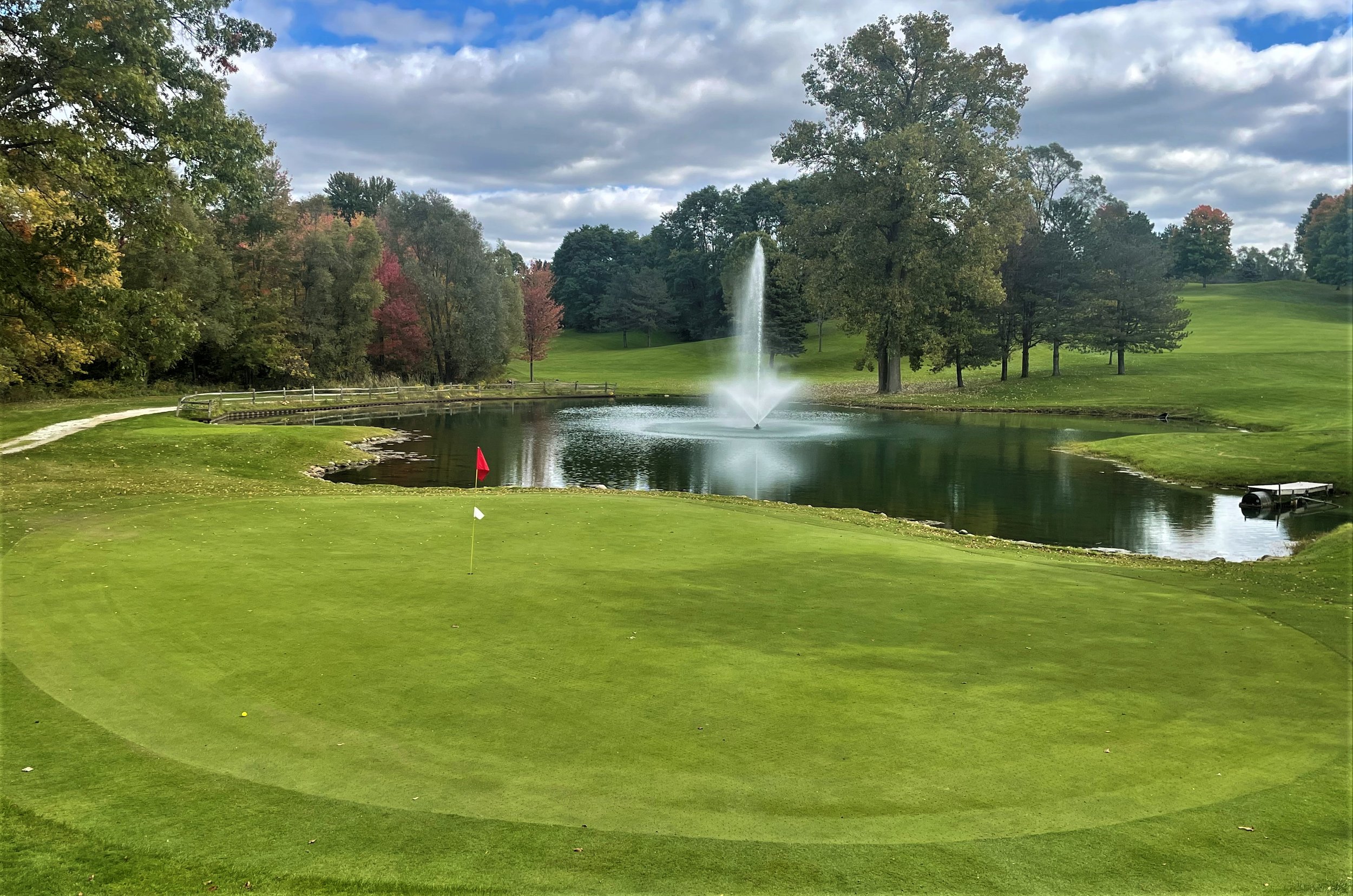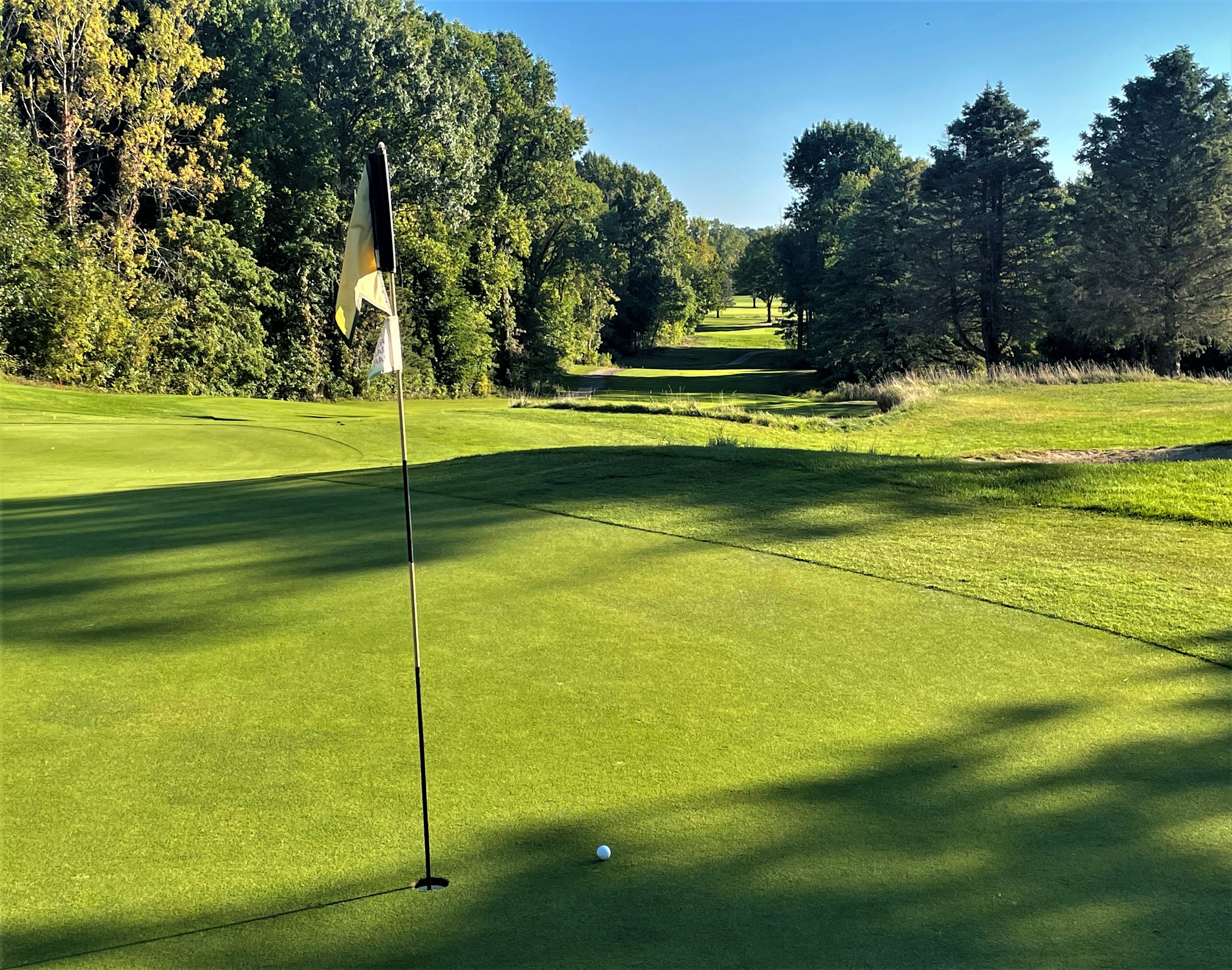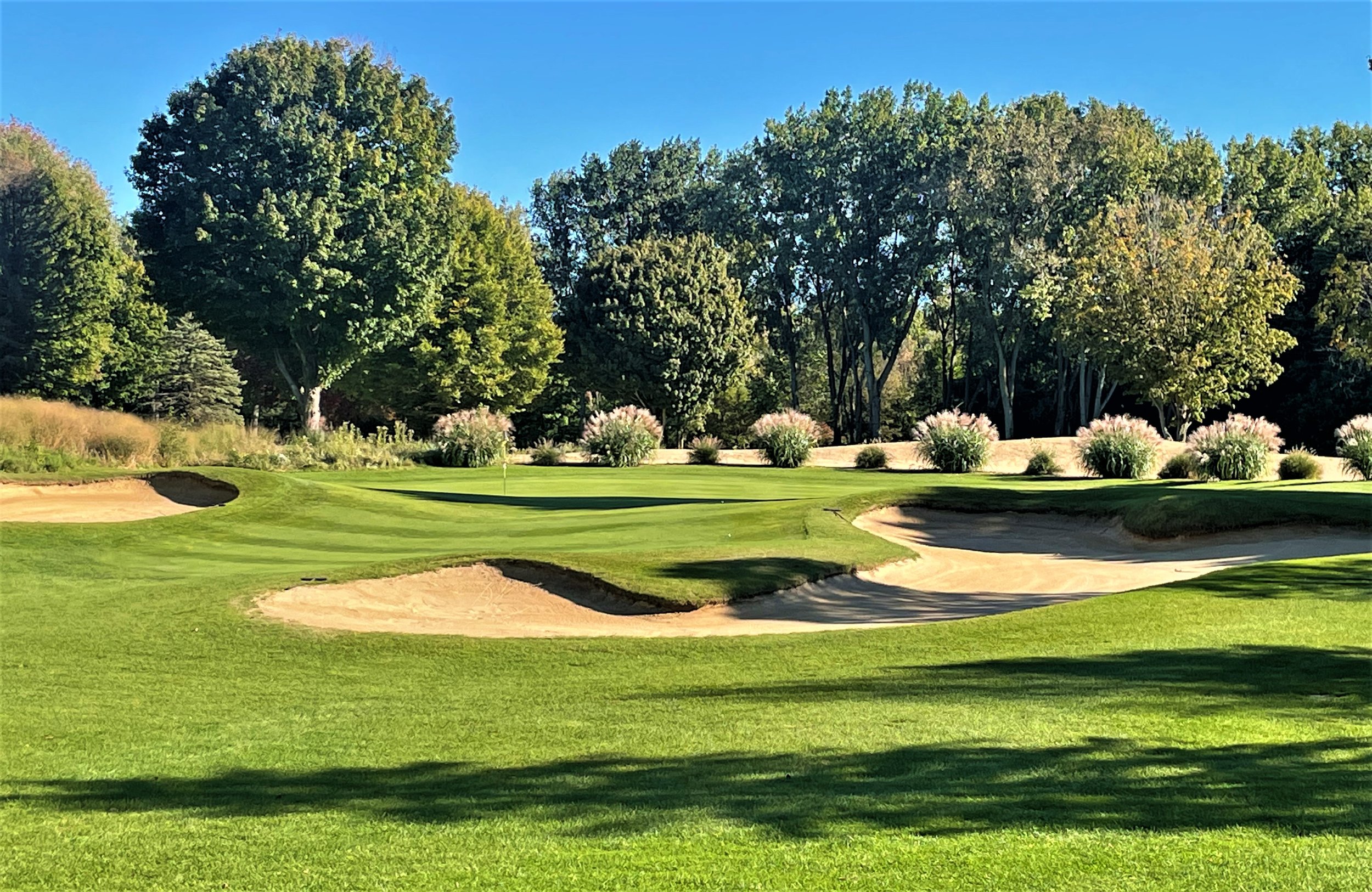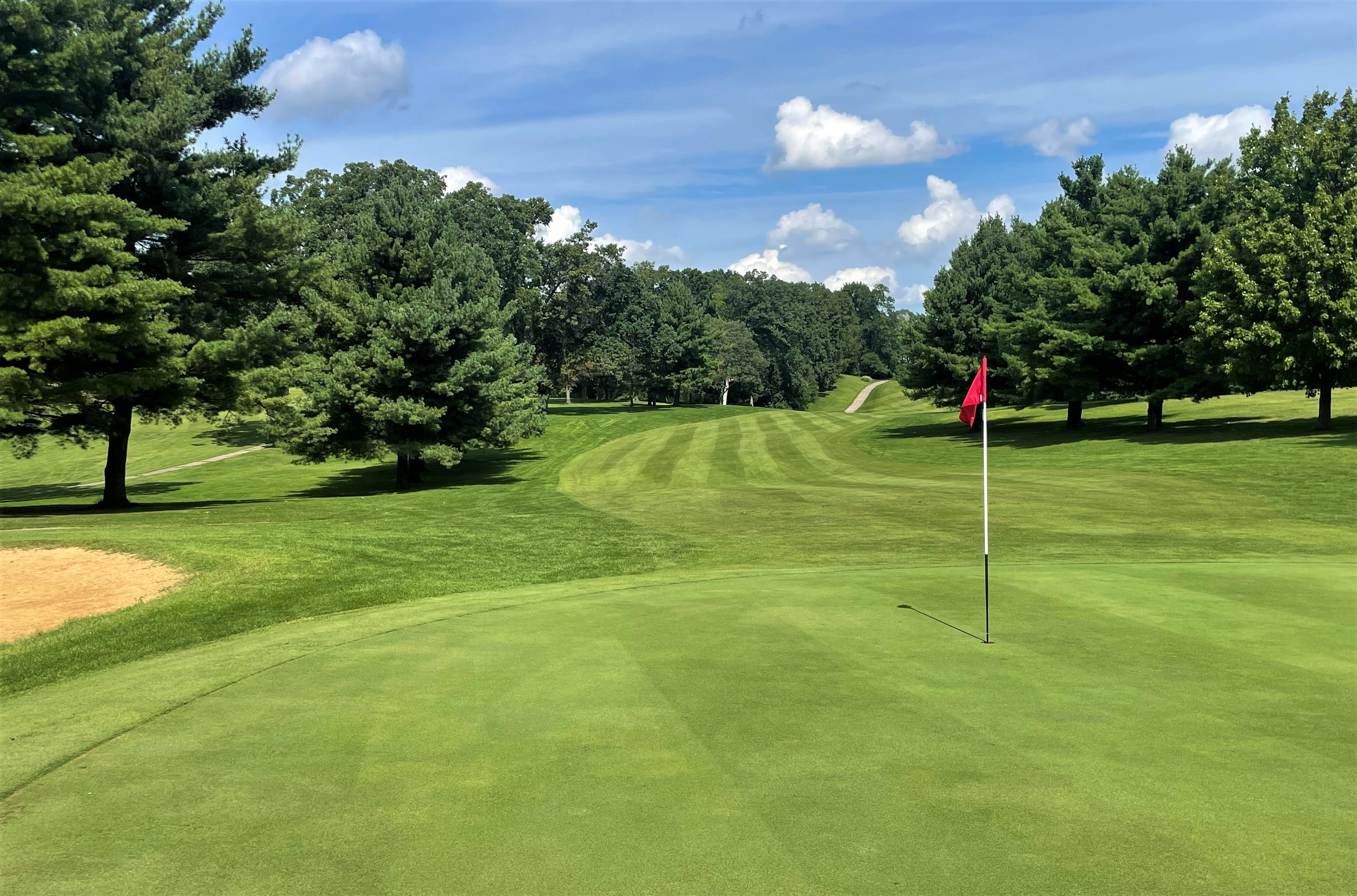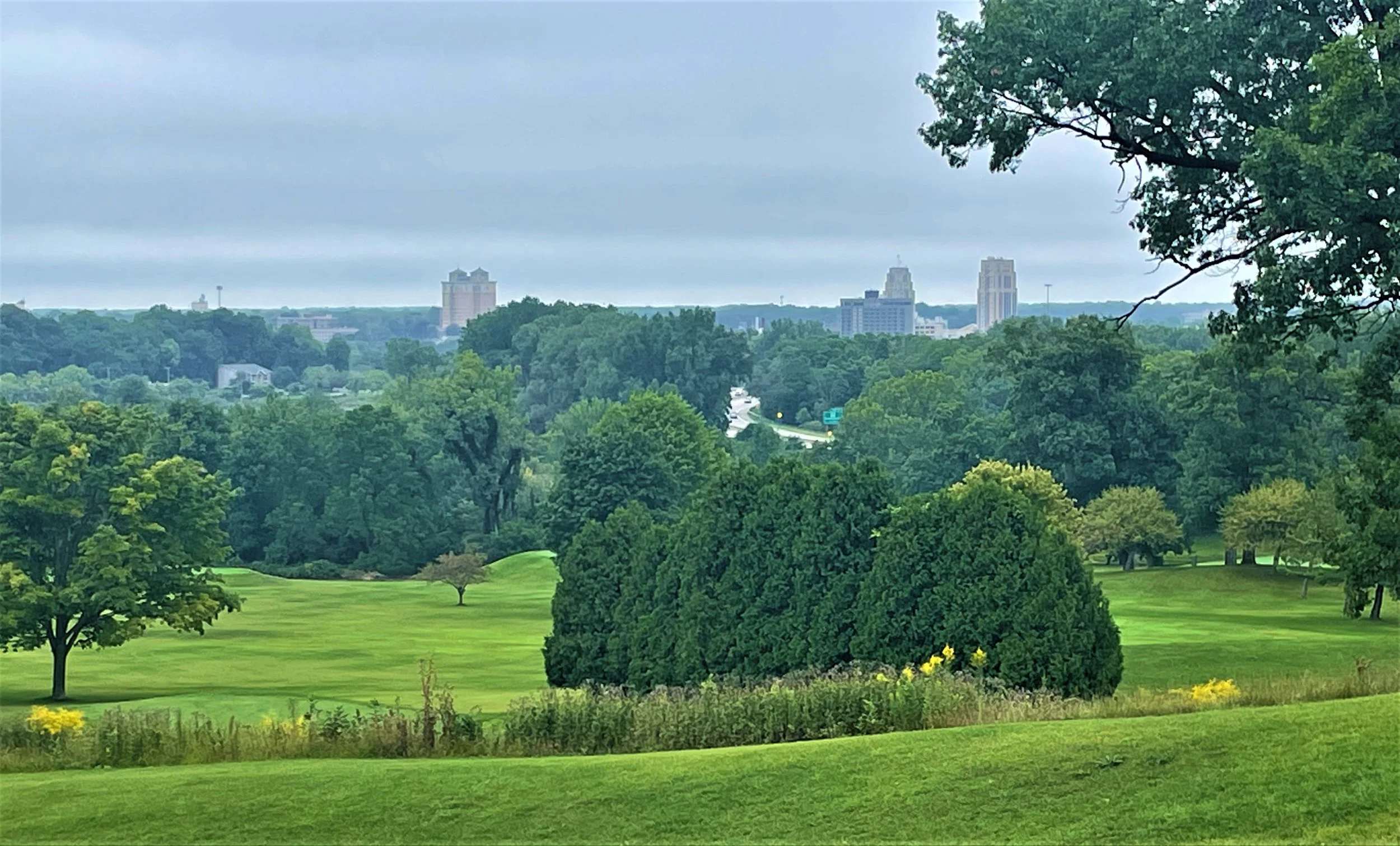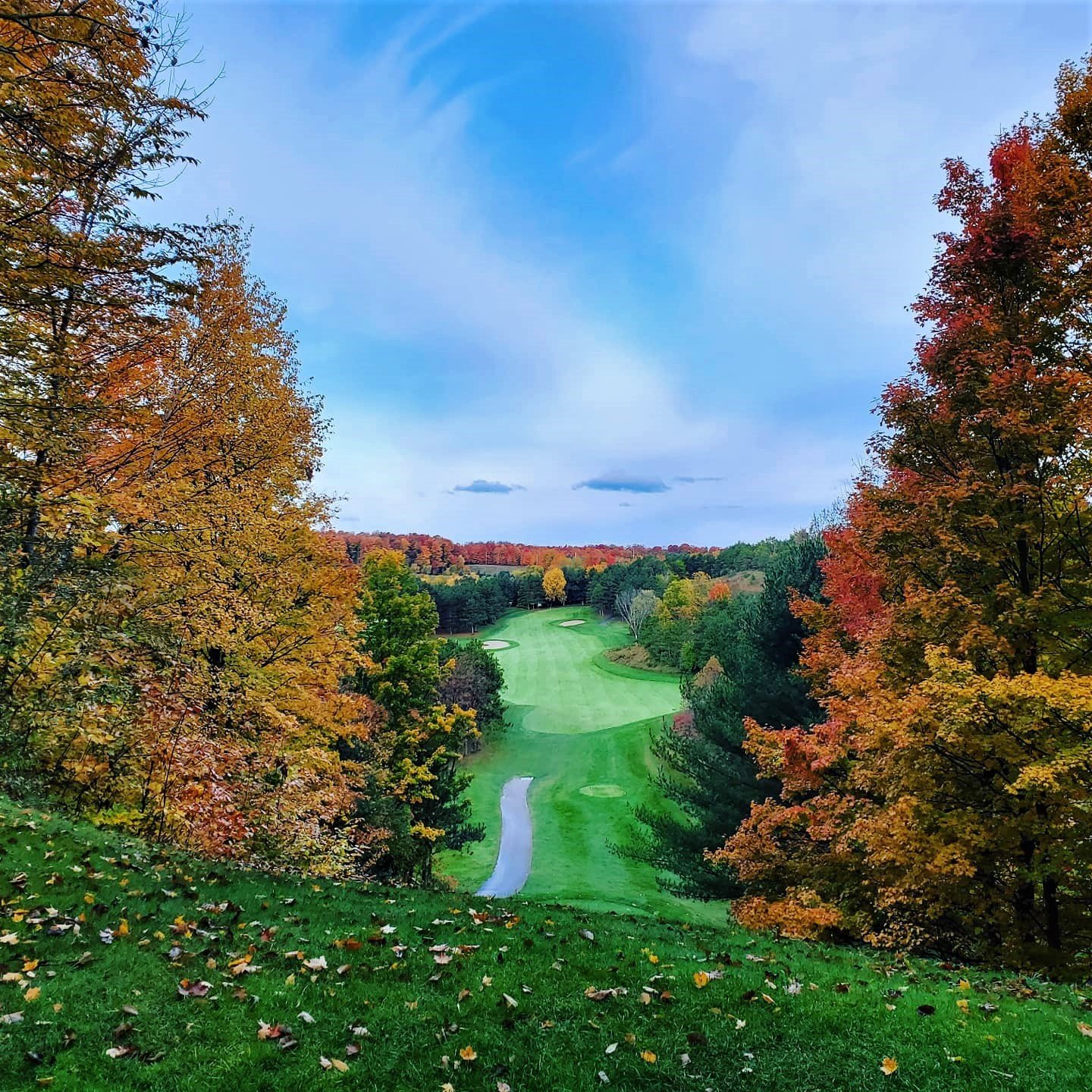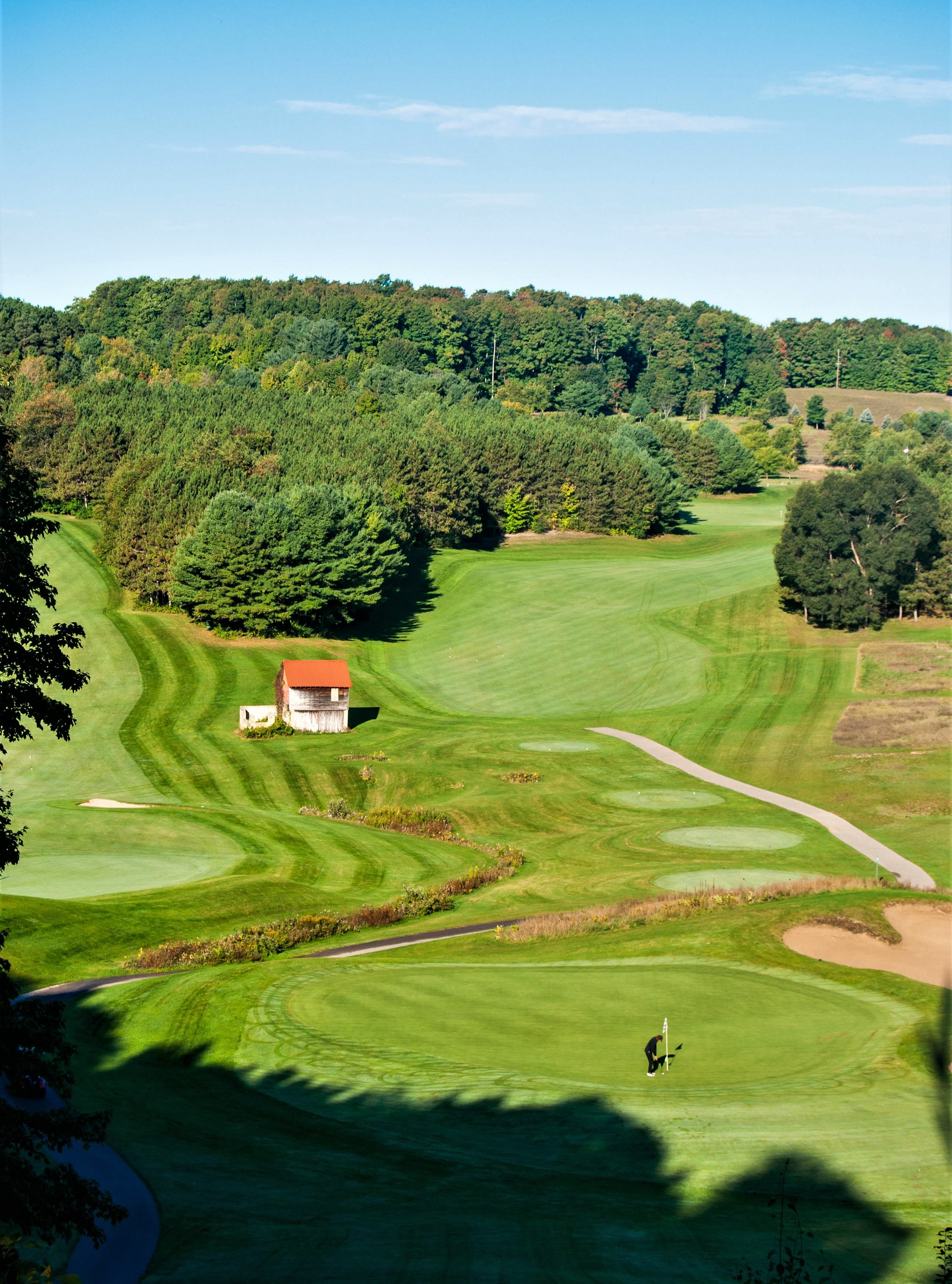Freeways and Fairways: Pierce Lake, Chelsea
This is part of an occasional series that looks at golf courses found along Michigan freeways – those you drive by frequently, or on that annual vacation, but never seem to have time to stop and explore. Maybe you should.
By Tom Lang
Pierce Lake is a wonderful municipal course west of Ann Arbor that too many I-94 commuters pass by in their busy lives. It’s truly one of the better ‘munis’ in Southeast Michigan, with very reasonable prices for a course filled with challenge, beauty and fun.
Trees line many holes, but on the front nine they are pushed back away from the wide fairways allowing for a much more open-air experience. A good variety of shot shapes are required and the rolling terrain is a pleasant surprise in the region.
Hole 9 is a really nice closing hole (if you choose not to make the turn), as it goes downhill all the way and gives your drive an extra 20-30 yard kick. If you do make the turn, 18 is also a great closing hole, but is unique in that it’s a long par 3. Even from the middle tees it’s roughly 200 yards to a huge green complex that’s more than 50 yards deep and is framed by a high-banked hill to the left.
The holes where the freeway is evident are easily No. 2-5, then 10-13 on the back nine. And it’s the back nine where the fairways narrow, and accuracy is at more of a premium. Eight of the back 9 holes require going over a marsh, creek or pond either directly in front of the tee, or somewhere along the approach to the green. Of course, forward tees give a break on some of those tee shots.
What jumped out at me is that many holes are actually more attractive when looking from the green back to the tee, so don’t forget to turn around after picking up your putts and enjoy the land you just traversed – a trip I enjoyed the entire time.
More information: https://www.piercelakegolf.com/
Celebrating a Century: Sauganash Country Club
By Tom Lang
Tucked deep in the southwest corner of Michigan, about 10 miles above the Indiana border, is an unassuming but wonderfully-historic golf course that turned 100 years old this past season.
Located south of Three Rivers along the CSX railroad tracks that dissect the small town, Sauganash has maintained the long-time name tradition of a ‘country club,’ but gets about 60 percent of its play from the general public.
I golfed with one owner and two members on an early-October day, before the leaves had fully turned to Michigan’s brilliant annual color show.
Technically, the property has almost two dozen owners, one of which is Rick Daniels. The group kept the course from nearly being sold off about nine years ago to become a new corn field, until the group revived it.
I love the front nine most, the original layout assisted by design legend A.W. Tillinghast, the famous architect of Baltusrol, Bethpage and Winged Foot. Once teeing off, there is little doubt the historic nine is this one, the way it is routed across the rolling landscape. Tillinghast took wonderful advantage of placing greens in the right spots of the key landforms.
A deep valley guards the approach to both elevated greens on holes No. 1 and 8. When we arrived at the latter, I told my playing partners that it was very clear this was originally designed as a square green – and the more I think back about it, No. 1 could have been, too.
Holes 10-18 are a challenging assortment through the woods and bordering the river on the back nine – a layout which was added in the 1970s. The back nine has more open spaces filled with natural golden heather between fairways. Holes 10-12 all turn left, the latter two wrapping along the Prairie River. Hole 15 also turns left. The rule of thumb for playing Sauganash is, on the front nine don’t go right off the tee, and on the back nine don’t go left.
“When you’re in a small community like ours, things just become part of the community. And this golf course has been part of the community for over 100 years, and nobody wanted it to go away,” Daniels told me. “We have at least 10 owners that don’t even play golf. They just came in to help save it.”
Daniels went on to describe what they call ‘The Dark Years’ – when previous ownership let things go to the point almost every golfer in the area said they’d never come back. Grass had turned to almost dirt on more than half of some green surfaces. One of the owners has grass and fertilizer experience and he agreed they could get it all to grow back. It did, and very well for some wonderful greens to putt on. Daniels said that word of mouth of Sauganash’s revival only took about 6 months.
Daniels said the owners are not looking for a big payday; they simply want a great place for members and visitors to play golf, to support jobs and recreation in the community, and maintain a fun gathering place for residents.
He cited an example of Thursdays, when Sauganash has $20 green fees, and that includes a hot dog. Now it’s the busiest day of the week.
“I see all the time golf courses, on Saturday and Sunday, jack their rates up. Why?” Daniels asked. “You want to punish the guy who’s working Monday through Friday? You want to take advantage of him?
“We keep our rates the same all the time. We don’t want to penalize you for having a full-time job. We want you to come out and play golf.”
Daniels went on to share: “The 100-year anniversary party was just so much fun. We had to have over 250 people here, maxing the place out. When it’s a small community it becomes part of the community, and that’s the way this golf course has always been.
“And that’s why we wanted to keep it.”
100 Years: Sharp Park in Jackson
By Tom Lang
One of a half dozen Michigan golf courses that turned 100 years old in 2024 includes Sharp Park Golf Course in Jackson. It was the starting grounds for virtually every player in the community, including three men who recorded several PGA Tour victories – brothers Dave and Mike Hill, plus Brian Stuard.
“When you think of golf in Jackson, one of the places you think of is Sharp Park,” said Stuard, winner of the 2016 Zurich Classic in New Orleans that put him in the 2017 Masters. “I have some great memories of winning the Junior City Championship at Sharp Park. It was always such a fun place to play.”
I built my own memory there in September, one week after playing at the fabled American Dunes in Grand Haven. The comment I shared with my random playing partner at Sharp Park was that while the two courses were polar-opposites in style, size and persona, I had fun at both.
Sharp Park is a fairly-typical municipal course, in that many of them around the country are inside city limits, are land-locked and thus, a shorter parkland style. The Jackson land has some nice gentle rolls to it, enough to even create a handful of unexpected blind shots.
My favorite back-to-back holes are 12-13. Hole 12 is a long par 4, made longer and more memorable by a well elevated green. My best summation is the large green sits 40-50 feet above the fairway.
After being happy with a bogey there, golfers move on to the short par 3 blind shot hole 13 – blind because the entire green complex sits in a bowl below the fairway run up where an extended flagstick barely shows from the tee the tippy top of the flag.
The green complexes are not overrun with sand traps. Most holes have only one trap to avoid (seven holes have two traps). This makes for a less egregious golfing environment, but they’re still nice deterrents that require some accuracy for scoring success. Several greens have run-off slopes on the sides and back that demand precision on approach as well.
The only water on the course sits right of the 2nd green and in front of No. 8’s back and middle tees. Each fairway also has a junior tee. Translation: this is a good course for those learning the game, while still testing good players.
There is a good mix of long, average and short par fours – the latter being short enough for some to try driving the green. But beware, as mis-hits will be penalized.
A very nice surprise for playing an affordable muni that is a good walk, is that their power carts have a nice GPS system. Not top-of-the-line luxury, but still very useable and helpful.
The clubhouse is a classic style, with an older home first on the property serving as the main core. Extensions made to the building since then are architecturally tactful and cool.
The Tom Bendelow design has barely been modified over the years, but at least three greens were moved in the past couple decades in an effort to give more space from possible wayward golfers’ shots. The course is designed as you would expect for Bendelow’s era a century ago – and it still holds its own as a classic.
Course Review: Cherry Creek in Shelby Township
By Tom Lang
I unexpectedly found myself playing at Cherry Creek Golf Club in Macomb County this summer, and I unexpectedly enjoyed it.
My overall impression of the property was its aesthetic appeal and beauty – which doesn’t come often in a high traffic area like those bordering the M-53 highway running north and south. Yet that is what I found when playing in a media and sponsors event the week of the Cairns Cup, an international match play tournament for adaptive golfers with various handicaps like missing limbs, blindness and neurological challenges. By the way, the U.S. team won for a second year in a row, with almost half of the national team members coming from Michigan.
In general, I really enjoyed the course. My notes indicated that some of the holes are rendered to target golf to avoid a fair amount of water on the course.
The overall land is also flat, making for a very walkable course if you so choose, but very nice man-made shaping added to the beauty of the challenges. It’s a Lanny Wadkins/ Mike Bylen design.
I also recall that the greens had much less break to them than the eye test revealed, so take that into account when lining up putts.
No. 8 was fun as a drivable par 4 dogleg left (not drivable for me), but with an over-abundance of sand traps protecting the green.
The sister courses in the Cherry Creek portfolio include Pine Trace and Shepherd’s Hollow – a very nice collection of properties. If you haven’t tried it, Cherry Creek needs checking out.
Watch action of the Cairn's Cup here:
100 Years: Elk Rapids Golf Club
By Tom Lang
Donald Ross designed.
A century of service.
Vintage.
Beautiful waterfront on turquoise-tinted Elk Lake.
Playable and filled with charm.
All are appropriate descriptions of the 100-year-old Elk Rapids Golf Club, a half hour drive north of Traverse City up the coastline of Grand Traverse Bay.
Prior to opening on July 17, 1924, the townspeople of Elk Rapids were struggling to make the area relevant for tourism after the logging and ironworks industries began to slow down in the early 1900s. Summertime retreats were not all the rage as they became more so a few decades ago, but Elk Rapids had a great location squeezed between the GT Bay and area lakes to draw people out of Chicago and Detroit for relaxing retreats.
Historians indicate that Ross must have been swayed to help guide a design for their small town by wealthy Chicagoans who frequented Michigan’s northern woods in an era when Ross was at the height of his golf design business.
The course is classic Ross, a links style using the shores of Elk Lake – which can be seen from every single hole except No. 8 – as the main core.
The course opens with and closes with par 5s. With yardages ranging from 2465 to 3067 yards, most golfers will not need driver. Accuracy is more important on the open yet heather-lined fairways.
Fairway bunkers are trimmed with tall grasses and have elevated ridges on the back side of each, requiring a higher-lofted club to get out. Some, but not all, greens have typical Ross ‘false fronts.’
My playing partner in June was Chris Blasy, a Midland native. We had never met before and although he visits in the summer, like me he had never tried the course before.
"Beautiful little track. A lot of fun and great for just a nice afternoon round to catch 9 holes,” Blasy said. “You could shift around to different tees and play it twice, or just being able to fit in a quick 9 before going out on the lake.
"The layout was very playable. I've played several Ross courses but don't remember the specifics about them, but absolutely this was made very playable and a fun track, and you can score."
My favorite stretch were holes 4-6.
No. 4 runs along the south edge of the property and heads toward the lake. The approach shot is blind to the green because of a slight ridge before reaching the more sunken green complex near water’s edge.
No. 5 is a par 3 right along the lake. The green is elevated with a false front and is guarded by a natural mound framing the hole on the left side, and a huge tree on the back right.
No. 6 is the longest par 4 on the layout, also along the beach.
Most golfers walk this course. It was designed that way in the first place, and although it’s not flat, the slightly rolling hills are not taxing. When it rains, the course drains dramatically well with its sand base and natural drainage to Elk Lake.
Members have made recent improvements in and around the already nice-looking clubhouse in anticipation of reaching the century mark.
If you cannot have fun on this course, you might want to consider playing a different sport.
More info at: www.golfelkrapids.com
100 Years at Grayling Country Club
By Tom Lang
With holes 17 and 18 meandering parallel along the AuSable River, a round of golf at Grayling Country Club can feel as peaceful as a lazy river float.
That’s been the scene for 100 years in the small northern Michigan town, once an epicenter for logging and the manufacturing of arrows at the former Bear Archery company. Old wood moorings of a former lumber company dock on site still poke up out of the river along the 18th hole shoreline, marking an eerie connection to the past.
It’s very common that 100-year-old courses in Michigan first started as nine holes and later expanded to 18. What’s a little unique about Grayling CC – which is open for public play – is that it remained nine holes for almost 70 years before the expansion in 1990.
When the redesign took place to double the course’s size, the new holes were weaved into open land on property – instead of creating an entirely new back nine. The nine original holes are now played as holes 1-4, then there is a jump to 9 and 10, then finishes off as holes 16-18.
The course is filled with old, majestic white pines that survived the lumber days of Grayling. Two of them guard the front of the 15th green. Since the course plays only 5,800 yards from the tips, it’s a great layout for families, friends and social outings – but there remains enough obstacles and twists and turns to make it a strategic challenge for even the best golfers.
Former manager of the club, Rob Lawe, is now one of 75 stockholders in the club. Now a lawyer by trade, he first began in 1992 at age 12 cleaning carts for free golf. He’s been on staff or involved with the club for 32 combined years. Lawe is focusing on saving those majestic trees, “as long as Mother Nature allows” to help battle the shorter yardage of the course.
“Having those in play can dictate your shot,” he said. “That also makes it one of my favorite things about the course.
“We have enough doglegs and water features that you definitely have to keep the ball in play and hit it to certain spots. And from some of the back tee boxes you really have to shape many of your shots right and left.”
A severe tragedy hit the Grayling CC in April of 2013, when the Grayling High School golf team was involved in a fatal car crash traveling home from a Traverse City tournament. Head coach Jason Potter and player Louis Menard IV were killed. The crash and aftermath made national news and former Golf Channel personality Matt Ginella attended the one-year anniversary. Now, a permanent memorial sits at the back of the clubhouse near the 18th green, made of stone pavers, a firepit and three rocks with commemorative wording carved in stone.
A third player, Jake Hinkle, was in critical condition with brain injury and a shattered femur and went many months in rehabilitation – yet made an amazing recovery to play golf in the following year’s high school state finals, and at a D3 college after high school.
From that tragedy, a foundation honoring Potter was established, with the funding going to promote and fund junior golf for the kids in town. It supports:
Hosting the club’s own golf clinic for 4 days each June
Sponsor the costs for kids to attend additional youth clinics in the region
Purchasing dozens of sets of youth clubs to have onsite all summer long at the club, up to 80 sets, for kids to use free anytime. Clubs are stored in what they call Jason’s Locker.
$1,000 golf scholarships each year, for each of two kids from the Grayling golf team.
More info at: www.jasonpottermemorial.com and www.graylingcountryclub.com
Boyne Mountain: The Alpine Course
The resort’s second oldest layout is not second tier
By Tom Lang
Boyne Resorts has a lot to be proud of in the golfing world.
Choices like elevated views of Lake Michigan/Little Traverse Bay at Boyne’s Bay Harbor, and the first championship course ever built in northern Michigan – The Heather, designed by Robert Trent Jones, Sr. and voted the 2019 National Golf Course of the Year – are just two examples which can tend to overshadow very nice golf on other layouts; like The Alpine.
The latter was the second course ever installed at Boyne, in the 1960s. Boyne now has 10 golf destinations in Michigan located above the earth’s 45th parallel. The Alpine is one of two courses at Boyne Mountain, along with sister course The Monument, which was fourth in the Boyne Golf construction timeline.
Each August, The Alpine hosts the prestigious Tournament of Champions, a uniquely special event put on by the Michigan PGA Section that molds pros and amateurs, men and women, juniors, mid-Ams and senior golfers together at one event to go head-to-head, sans varying tee boxes.
“Personally, I love the Alpine and it may be my favorite Boyne course,” said Kevin Helm, executive director of the Michigan PGA. “That is not meant to take anything away from the others, I just like the layout, mix of holes, and how everything is pretty much right in front of you.
“Combine that with consistently excellent turf conditions and you have a great venue to host our Tournament of Champions. We hear a lot of similar feelings from the players as well. The greens can be difficult to read if you do not have a lot of experience playing there, but players still talk about how much they enjoy playing the Alpine.”
Although it’s sometimes cliché in the golf world to say ‘no two holes are alike’ that phrase does aptly describe the Alpine. For example, even the three dogleg left holes each play differently and have their own distinguishing look and needed strategy.
Designer Ray Hearn developed a 10-year plan to change and update, in some small and some big ways, all of Boyne’s golf properties.
At The Alpine, fairway rough around bunkers has been cut down to fairway height. It provides a clean and cool look, but also makes the course more playable for the recreational golfer… but doesn’t necessarily make it easier to score for tournament golf.
I found the greens to be relatively large compared to other courses. They have very little undulation, but that said the slight breaks in the greens can be very hard to detect and read, to make putting just as difficult as if there were many hills and swales in the putting surface.
Speaking of putts, when reading do not forget where the mountain is in relation to the angle of your putts. Most will break away from the mountain top, even those that look flat, in the direction of Deer Lake in the valley.
Hearn’s plan included implementing a shorter cut around most of the greens to make them feel extra expansive and more attractive – and to increase a golfer’s choice to chip or putt when off the edge.
A nice change was on hole 2, a shorter par 4. The second shot is a full carry to the green to clear a pond, so one improvement was to take out a bunker just over the water but before the green to remove the penalty of just making it over the water, to only drive up and find the beach.
Check out The Alpine and any of the other delightful Boyne choices in northern Michigan.
BOYNE Golf New Short Course Named Doon Brae
BOYNE Golf’s newest, and 11th overall, golf course in Michigan has been named Doon Brae.
It’s the new par-3 short course located on the backside of The Highlands Main Lodge and is scheduled to open summer of 2024.
“What excites me most is how beautiful and different it is,” said Bernie Friedrich, Director of Golf Course Renovations and Development at Boyne Resorts said about the course constructed on the downslope of an active ski hill. “There are three or four stacked wall bunkers. Instead of using tee boxes, we'll have just one marker on each hole and let guests play wherever they want.
“And the greens are inspired by some of the great ones around the world. They're not copies of any specific greens, but they look different and are big. There's a lot of excitement about short courses. We want to keep people excited about golf and wanting to play. If playing 18 or 36 holes is not enough on any day, this gives golfers another option.”
The name Doon Brae, where Doon means going down into a valley and Brae means steep bank or hillside in Scottish, is fitting as the routing of the course is set along the hillside that doubles as a ski slope during the winter months.
Michigan golf course architect Ray Hearn was selected to create Doon Brae, among other work he’s been doing to renovate several courses in the BOYNE Golf portfolio.
“Drawing on our inspiration from the British Isles allowed us to create scaled down versions of famous template greens highlighted by The Short at National Golf Links,” he said. “Other green templates include Eden, Punch Bowl, Redan, Reverse Redan, Volcano, Steep Slope, Postage Stamp, and Biarritz."
The course, which will measure 993 yards from the back and 678 yards from the forward areas, will feature a variety of fun yardages with downhill, flat, uphill and sidehill lies, generally moving horizontally back and forth across the slope. Holes range from 57 yards to 134 yards, with very few uphill walks.
The new course, along with the 1.5 acre nine-hole Himalayan-style putting course, are both designed to be fun for everyone. They will create an entertainment area for golfers and families alike to hangout well into the evenings, creating a new level of energy in this space. The golf course will also be lighted, play music, along with food service and fire pits.
"Guests will really enjoy the uniqueness, character and fun atmosphere around the new course and putting green," said Josh Richter, Senior Vice President of Golf Operations for Boyne Resorts. “And with the new Himalayan putting green also being built, we're creating a pretty cool and huge golf gathering space. Guests can gather for games and fun, while enjoying their favorite beverage and taking in all the beauty of Northern Michigan. It's going to be a heck of a space for all to enjoy in way that is best for them. Having music playing as well will make it a fantastic entertainment environment."
Masterpiece is Simply That
By Tom Lang
Sometimes there’s great power and simplicity in a name.
At Treetops Resort, that is certainly true with the original course onsite designed by Robert Trent Jones, Sr. – The Masterpiece – which opened in 1987.
The very first hole grabs a lot of attention when visitors pull into the main entrance at the resort’s original south location, as the first hole meanders downhill right at you. All the other resort golf was added to the Treetops North location about 5 miles up the road, where golfers will find the Smith Signature, the par 3 Threetops, the Smith Tradition and the Fazio Premier.
With a slope rating of 147, the Masterpiece is a beautiful modern architecture type design, but since it was completed several decades ago the layout could be called ahead of its time. There’s an excellent use of the natural landforms with twists and turns, including the No. 6 hole – often considered the most iconic in the Treetops collection. It’s there where Jones looked out over the Pigeon River Valley landscape and told then-owner Harry Melling, he should call the place Treetops.
I found that there is great use in the design of high elevations and some lower areas where water naturally collects on the property, especially holes 8 and 9.
While there are so many good holes to choose from on the Masterpiece, my favorite string of three consecutive back-to-back (to back) are 13, 14 and 15. They may not stick out in a lot of golfers’ memories, but the variety and sightline views are wonderful. Hole 13 is a medium-length par 3 hitting to a two-tiered green over a small gorge with water in the bottom. On 14, check the yardage off the tee because the end of the shorter fairway – not far past the 150-yard barber pole – has a severe drop off into natural rough that could snag a golf ball for life. But keep your drive near the 150-yard marker on the flat fairway and you will have a clean shot over a ravine to an elevated green that is skinny but deep. The land disappears behind the green as well, so some precision is needed.
No. 15 is yet again another highly-elevated tee, on a short par 4 down into a valley before going back up a little to the perched green – a green which is heavily guarded by bunkers yet is still playable by virtue of the fact this lower-than-avg golfer made a 4-foot par putt.
While playing the Masterpiece in September, I came across two women having the time of their lives. They were sporting new Treetops lap blankets, a gift from the resort for their longevity of visits.
“You don’t have to be intimidated here,” said Sheri Everitt of Sterling Hgts. “We’re on the Masterpiece right now; we originally thought we could never play the Masterpiece, like ‘we’re not worthy.’ But we’re having fun here. It’s relaxing with the views.
“For the value, and being three hours away from metro Detroit, it’s an easy drive, the service, that staff have all been outstanding. The price is great; and you can look for specials.”
Her long-time friend and playing partner, Karen Gray of Troy, was giddy about spending time with her friend up north.
“Because we book with the same agent, Kristen Hughes, we always get the same elegant room, with a kitchen,” Gray said. “But what excites us the most is the elevation of the tee boxes. It’s hard to find this anywhere else in Michigan. The high tees is why we love it here. And I love the Lee Trevino hole (on Threetops).”
Eagle Crest Golf Club Has It All
Indoor, Outdoor, College Training and more
By Tom Lang Photos by Randy Mascharka
Golfers like me appreciate when course owners and operators never rest on their laurels – always evaluating what they offer to the golfing public and, if needed, at least making small adjustments to keep things fresh when possible.
Eagle Crest Golf Club along I-94 in Ypsilanti is just such a place – although its recent adjustments are not small at all. They are HUGE.
Already ranked No. 5 in Southeast Michigan by the Detroit Free Press, and 13th nationally for best public courses based at universities, Eagle Crest is a calming resort atmosphere on Ford Lake. When there, golfers won’t even notice or hear tens of thousands of cars flying by on the nearby section of freeway connecting Ann Arbor and Detroit Metro Airport.
While several sections of the course have been renovated in the past 10 years, the new, huge addition is the two-story Clubhouse expansion with its TrackMan Simulator Room. The new 2,200-square-foot facility has 4 TrackMan bays and lots of people gathering spaces – but what sets it apart from any indoor facility I’ve ever seen in Michigan: the back wall is all glass, and from its high perch it overlooks the golf course with sprawling Ford Lake in the background. It’s without a doubt one of the best golf views in Michigan, especially when golfers are cozy warm inside during the off season.
Additionally, the men’s and women’s golf teams at EMU have their own new building right next door. The new two-story tall EMU Performance Center is 13,000 square feet, where almost the entire men’s and women’s golf teams will have room to practice simultaneously, said Stephanie Jennings, the women’s head coach and also the first ever female Michigan PGA President.
“It’s a game changer,” Jennings said emphatically. “It takes our golf programs (men and women) into a whole different level of where we can go now. A lot of the teams that have been performing better than us have had buildings like this for a while, and now we’re going to have better facilities than some teams we compete against.
“So, it’s getting the top recruits to come in and see what we have, not only that building, but the golf course right here that’s all connected and how we can showcase the sport of golf here at Eastern Michigan.”
The public TrackMan Simulator Room ‘showcase’ opened just before Thanksgiving and golfers have already been in to hit balls, track their swings and golf ball statistical patterns, play one of 265 simulated course choices from around the globe, and enjoy great food and drinks with their friends and family while gazing out the wall of windows.
The four TrackMan bays allow golfers to measure all parts of their swing, flight line, the club speed, ball speed, smash factor, and more – and get it all on video from 3 cameras in a split screen. An app will allow review of all those characteristics at any time.
“I’ll start looking at how I’m turning, how I’m rotating – the things that I’m working on – so when I have a few minutes or cannot sleep, I can break it down anytime on my laptop or on my phone,” said Eagle Crest GM Wes Blevins, now in his 13th year.
“The whole point of doing this building was to keep up with (golf) technology, and with what is happening in the golf industry,” Blevins added. “Indoor simulation rounds just keeps getting bigger and bigger,” he said, adding that it’s a good alternative not just for indoor golf but for people who don’t have the time for 4-5 hour rounds of golf outdoors.
Blevins touched on the fact that the number of people that play ‘off course’ golf has grown to the point its numbers are greater, by a few percentage points, than the number of people who play traditional on-course golf. Some of those numbers include both types of golfers, but still, think about that for a minute.
Additional recent figures from the National Golf Foundation say an estimated 6.2 million Americans hit golf balls with a club in a golf simulator (or facility like TopGolf) just within the past year, a total that’s surged 73% compared to pre-pandemic levels. In 2019 and years prior, simulator participation had hovered just under 4 million.
Eagle Crest has developed an Indoor/Outdoor Practice Club (IOPC) Membership. For $250 per month, members get unlimited one-hour time slots non-peak times – Mondays through Thursday before 4:00 – on TrackMan. During peak times the membership provides a 20 percent discount. Included is two 1-hour lessons from a PGA pro, 10 percent off pro shop purchases and no initiation fees and no penalty for cancellation.
The outdoor portion also includes unlimited balls and time on the driving range, short game practice area and putting greens.
Blevins envisions people using the indoor facility not just in cold weather, but some might use it in the summer in the more comfortable air conditioning to warm up and analyze their swing before going outside to play 9 or 18. Then there is a second level – a wide open room for parties, holidays, wedding showers, and more. The onsite Marriott will be booking corporate events and the bays are open for those kinds of events as well.
Tournament Quality Golf:
In addition to being the home course for the EMU college teams, Eagle Crest hosts NCAA events, high school state finals and national junior tournaments. In 2025 and ’26 it will host the NAIA women’s college national championships.
Blevins said the coaches love coming to Eagle Crest because it’s all self-contained with the hotel, new performance center, large and good-looking range overlooking the lake, plus food all in one spot.
“They can stay here overnight, they eat here,” he said. “They can park their vans and not have to go anywhere else.
“And with the Marriott right here, it really is a great staycation type place. There’s lots of things to do without the long drive.”
Heading Outside:
Playing Eagle Crest has always been a lot of fun for me, but with the almost 10-year long tree removal program concluded, plus individual hole improvements and some fixed drainage challenges near the lake, it’s a great new experience if you haven’t tried it lately. There’s significant elevation changes not normally found in SE Michigan, with great water views on most of the course.
Hole 14 is the start of my favorite 4-hole stretch. It’s a severely dropping par 3 that has been opened up to more lake views behind the green – a wide open sightline to Ford Lake appears where the view didn’t exist before. All in all, the hole is much more visually appealing than in prior years.
Hole 15 is a shorter par 4 with a tee shot over the corner of a pond that runs the entire left side and juts in to protect a significant portion of the front of the green; yet bail out room remains on the right side of the approach.
Hole 16 is a very stout par 5. The tee shot requires a carry over a marsh to a wider landing area since more trees have been cleared out. The approach shot is to a peninsula green that extends out into the lake and is one of the nicer views on the golf course. Tree removal also on the left with some drainage repair has made the fairway firmer than before. Hole 16 was also lengthened.
Hole 17 is one of the toughest par 3s around if you play the back NCAA tees, making that a 250-yard poke. For normal golfer mankind from closer tees, it’s a beautiful par 3 with a good sized green protected by a wrap-around bunker that keeps balls hit to the right or long from going into the pond.
So much is going on at Eagle Crest we need more space, but check for yourself at: https://eaglecrestresort.com/
Coming in Spring: The Cardinal
The new course at Saint John’s Resort will marvel many
By Tom Lang
There is growing anticipation for the grand opening of The Cardinal, a new 18-hole championship course at the formidable Saint John’s Resort in Plymouth.
There is a reason the property used to be a full-time Catholic Seminary – turned luxury resort with a stunning wedding chapel dating back to the 1940s – as one could literally call the landscape ‘God’s Country.’
The beautiful, rolling land surrounding the seminary-turned-high-end hotel and conference center is the current-day setting for the new golf-centric development. Picturesque, tree-lined, and filled with wildlife is not an often expectation in such a densely populated surrounding area very close to I-275 and I-96/M-14.
After playing there in early October, what went through my mind was: A nature preserve with tee boxes and flag sticks.
The massive remodel in Plymouth – turning the former quaint 27-hole Inn at St. John’s Golf Course property into a championship level 18-hole course, with a bonus 7-hole par 3 short course and a 1.5 acre 18-hole putting course – has transformed the property at Five Mile and Sheldon Roads.
And in the process, resort golf has become a reality in metro Detroit. The Cardinal is slated to open in the spring. It is a public golf course with a country club atmosphere and experience.
Award-winning designer Ray Hearn headed up the project and believes all the elements are there to attract golfers of all skill levels – people who are just getting into the game, as well as families and friends of wedding parties or corporate outings who just want to have a little fun on the large putting course while they visit the resort for socializing or business.
“The growth of par 3 short courses and putting courses nationwide make great sense, especially with a hotel on property,” Hearn said. “You’ve got a lot of new people entering the game of golf. People want to have some quick fun, and then there’s Carl’s Golfland right there with a driving range and all the equipment.
“With a set up of 5-tees (on The Cardinal) you can do what you want based on your skill level. Pick the right tees and you’ll have a good time. You’ve got it all there with the longer 18, to play nine – or go to the 7-hole short course or 1.5 acre putting course.
“It’s Southeast Michigan,” he added. “This site is surrounded by buildings and residential and commercial sites to the north and west, yet this property is a beautiful oasis.”
All the investments have been made by the Pulte Family Foundation. After expenses are paid, all revenues will go into the Foundation for distribution to worthy charities. Golfers will literally golf for a good cause.
Typically in course reviews I pick my favorite 3-hole stretch. This course is so good I have expanded it to six – holes 13 through 18 – an excellent culmination to the end of a half day on the course.
The 13th is a par 4 with a sharply left-to-right slopping fairway to try holding, before the approach to the elevated green.
The 14th goes over the corner of a pond to the large par 3 green. Then 15 goes over the same water (from the back tees) to a fairway highly protected with a huge bunker on the right.
Hole 16 is a gorgeous par 3 with the tee and green level to each other, but with a huge natural valley splitting the gap. No. 17 is a shorter par 4 slight dogleg right, followed by the closing 18th hole. What used to be a short closing hole has been changed to a longer par 4 with an uphill blind tee shot (aim for the brick tower) to a wide fairway and green complex guarded by a large pond on the left that wraps behind the green.
Come back to MI Golf Journal in April for a longer review, and visit: https://www.saintjohnsresort.com/plymouth-michigan-golf-course-st-johns
Lynx Golf Course a Natural
High-end public golf found in Allegan County
By Tom Lang
Since relocating to west Michigan a couple years ago, I have had the chance to sample more courses outside of the metro Detroit area.
The Lynx Golf Course is one of those pleasant surprises.
Nestled on land high above and down along the mighty Kalamazoo River, the Lynx is a beautiful course in a very natural setting, sans two holes and one cart ride with condos along the way but which are pushed back from the playing area.
Hole No. 1 leads off with a great example of what golfers will find on their day. The fairway first appears flat and boring, but hit it to the end of the fairway and you’re faced with a 75-foot elevation drop to the green. Beware, however, that going long over that green, and many others and you’ll find big trouble.
The second hole, also a par 4, has a nicely elevated tee box starting the hole which has a large tree left that can cause some headaches.
Get to hole number 3 and the view widens to the more open part of the golf course – tree lined but more appropriately called tree outlined on holes 3-6.
Holes 4 and 7 each have a large tree just right of center of the fairway that has to be factored in with your tee shot to make sure the way is clear for the approach to the green.
The two par 5s on the front (holes 5 and 8), are both uphill to elevated greens, so from the tips at 526 and 488 yards, respectively, they are a little more beastly compared to the other holes.
In general, the Lynx has a fair number of blind shots, so playing it a couple times will make golfers more aware of the intricacies of the layout.
I played the front nine with Cathy Ptacek (and her husband) of Allegan and couldn’t have had more fun – a classic definition of how golfers can meet at the first tee as total strangers but during the round have a very enjoyable time together.
“I think the Lynx is very lady friendly,” Cathy told me. “Especially from the forward tees. I think it’s around just 4,450 yards, so as long as you have a good tee shot, the holes play pretty well.
“I think it’s very peaceful here,” she added. “I like that there’s not a lot of condos or houses around, except for a couple holes on the front, and the rest is pretty much just nature, so I like that a lot. I like the back nine the best. I think it’s a little bit more picturesque, with the river running through it. There’s a couple dog leg lefts but they play really nice and it’s laid out well.”
Unfortunately, I had to call it a day after nine holes but based on Cathy’s comments and what I saw on the front, I’d say a return trip to experience all 18 will be well worth the drive.
Freeways and Fairways: Clearbrook
By Tom Lang
Nearing its 100th birthday in 2026, Clearbrook Golf Club and Restaurant is clearly a special place.
And its location is very unique in having two holes (13 and 14) bordering I-196 – yet is only one mile from the quaint town of Saugatuck and just a hop, skip and a jump from the Lake Michigan shoreline.
Clearbrook’s history makes it special, as well as two distinct nines that test every part of your game. The front nine crisscrosses up and down and back and forth across a brook spanning over 2,000 linear feet trickling through the bottom of a fairly deep valley. Trees are plentiful but not intrusive unless you are way off line.
The back nine, which is about half the age of the original nine, is set more amongst the trees on the property. The fairways are tighter, but again, not suffocating. My favorite 3-hole stretch on the back is the closing three holes of 16-18.
No. 16 is a par five that turns a little, twice, to a green approach shot guarded by water left. The 17th is a classy par 3 over a small extension of the same water found on 16, and it’s usually into the wind.
After a short cart ride to the par four 18th that’s located back on the original property, you will find a highly elevated tee box and a large pond looming at the bottom of the hill on the right. The tee shot requires a decision to layup left of the water and in front of the creek – making your second shot uphill to the green that much longer. Or if you have a better-than-average drive you can clear the creek and have a shorter chip to the elevated green.
I’d say the signature hole is No. 5. It’s a shorter par 5 with an elevated fairway that drops off out of nowhere to a deep valley with the brook running through it to clear on your approach to the green. Even more challenging is the brook forks right in the middle of the action, leaving a few choices on open patches of grass. You might have to play it a few times to figure out the best choice of strategy.
If you have never played the course but the name sounds familiar, maybe you read the December 2022 edition of MI Golf Journal which highlighted the fact that Kirk Cousins, the former QB at MSU and current NFL quarterback for the Minnesota Vikings, purchased the golf course from Jim and Candy Jeltema.
The Jeltema’s first interest in the property when buying it nearly 40 years ago was always the restaurant/clubhouse, which was expanded about the time the course went from 9 to 18 holes. They are hospitality people by trade, having held executive positions at the Grand Hotel on Mackinaw Island before becoming entrepreneurs in the food and golf business in Saugatuck.
They continue to own and operate the restaurant, while leasing the golf course from Cousins, who should become more involved in future years, likely after football.
In the meantime, the Jeltemas continue to offer great food and beverages at what resembles a supper club mixed with family atmosphere. Their summer seating is doubled when including the porch outside overlooking a very well-attended-to garden that treats the eye and adds a flair of total relaxation after a round of golf.
More information at: clearbrookgolfclub.com
Freeways and Fairways: Eldorado
The Cadillac course along US-131
By Tom Lang
This course review is part of an occasional series that looks at golf courses found along Michigan interstate freeways – those you drive by frequently, or on that annual vacation, but never seem to have time to stop and explore. Here is my assessment:
Eldorado is a golf course that is either blessed or cursed to be right in the easy line of site for golfers heading north on US 131 every weekend because most are driving right past it with visions of further-north resorts dancing inside their dimpled heads.
But maybe you should slow down next time and give it a try. When I did in June, I was paired up with a father-son duo from California, who did just that – and we had a great time.
“We’re taking a day or two to get to our destination (Treetops) and this is one of the spots my dad pointed out on the way up last night and we thought we’d check this place out,” said Chris McKeon of Carlsbad, CA as we stood on the 18th tee. “No expectations. We had no idea what it is, and it turned out to be quite the gem.
“There’s a lot of open space, and there is a really nice look across the course. Very good views, and you can drive the ball without relying on being really tight, except a couple holes on the back nine. But for the most part it’s fairly wide open and you can let it rip. Super big greens, very fun course.”
The open property appears to be former farmland, in part because a clean white home and freshly painted red barn sit across the road to the south. The front nine is pretty wide open, except for the approaches to some greens where it’s narrowed down by trees. The back nine has more water come into play by far. Approximately one-third of the property has marsh land in which the back nine meanders its way to and fro.
No. 8 is interesting in that the tee box is tightly surrounded by trees, but it opens up to a wide fairway, which then squeezes down on the par 5 to a very skinny area at the end of a dogleg left, requiring an approach over the marsh to an elevated green with mounding across the back to catch long balls.
The closing holes 9 and 18 share a combined green that is beautifully shaped and adds a great amount of character to each finishing hole. Hole 18, a longer par 4, requires a solid drive off the tee or you’ll have a layup before going over a large pond to the large putting surface.
“I think it’s awesome here,” said David McKeon. “My son and I like to do these golf trips and have discovery golf, where we just pick a course, drive to it and see if we can get on.
“The people in the pro shop here were fantastic, and I would also say that everybody in Michigan that we’ve met, from dinner last night and the course we played (Bay Harbor), to this one, super people here in Michigan. A lot of nice people who have been so friendly to us.
“Eldorado is very different from what we play back home,” he added. “There’s more trees on this course than any we’ve played in CA. It’s got many forced carries and when you’re a high handicapper it’s been a challenge, but it’s been a blast.”
Course Review: Stonebridge Golf Club
By Tom Lang
Stonebridge Golf Course in southwest Ann Arbor was ranked the No. 8 public course in metro Detroit last fall by the Detroit Free Press.
It was a good call.
Despite living in metro Detroit for 30 years, I had never seen the course until early this May, when on a reconnaissance mission with three other golfers planning to host a charity event there in August.
It will be a good event.
Stonebridge is the Arthur Hills design set within the confines of a housing development. But the good news is it’s not confining. The houses are pushed back away from the playing area quite well, so as to not be intrusive on a majority of holes.
The fairways are wide and inviting off the tees. Playing the 6,000 yard tees, this 18 handicapper made it around quite well, sans the terrible day of chipping and putting (that said, the green complexes were partially responsible). Most greens had one or two flat ‘perches’ for challenging hole locations, and if your approach shot/chip didn’t find or stay on said perch, putting was a harder test of skill on the remaining undulating surfaces.
The par 3s were a workout. Even from the almost forward tees, two of them were 170 yards long. No. 4 is a gorgeous par 3 over the corner of a small lake. Then No. 6 has the tees set in a wide-open area, but on the way to the green things get very tight with sand bunkering and trees shrinking the gap immensely.
Hole 11 is a very unique par 4 with a 90-degree turning dogleg right. Following the cut fairway makes it almost 400 yards long, but just for fun I chose to layup the drive short right, which left only 145 to the green, over some water. The trade off is if you follow the fairway longways, you are hitting it to a skinny green that is very deep as to allow many club choices. Yet coming from the side like I did, the green is very thin ‘front to back’ (think Augusta National’s No. 12; wide but almost no depth). My ball wouldn’t hold the skinny green from that angle and trickled over and into the rough.
No. 14 might be my favorite. It’s pretty, and pretty tricky for the second shot. The par 5 turns right at about where most player’s drives would land. From there on in, the very wide fairway gets narrower due to a lake extension that you cannot easily see encroaching the fairway from the left, with the right side guarded by very large bunkers. The run up to the green is probably the skinniest section of fairway on the course.
A creek runs through the entire property, coming into play many times. And if you like watching small airplanes, the front nine is in the landing pattern of the local air strip. Lots of small and homemade planes to entertain the eye from below.
Maybe that’s another reason for terrible chipping and putting.
Course Review: Iyopawa Island Golf Club
Coldwater Lake
By Tom Lang
What I like about golf in Michigan is that we have so many different golf courses that cater to all kinds of golfer skills, price ranges, land features and golf challenges.
Per Google, I recently happened upon a course I never heard of before while hoping to get the winter rust off the clubs by taking advantage of one nice day near the end of April before another rain/sleet/snow cold snap came along. Anything within a one-hour drive, that seemed different than others, and might not be crowded would do.
I found such criteria in Iyopawa Island Golf Club, situated on an island in the middle of Coldwater Lake, 3 miles north of the Indiana border.
The course opened 91 years ago in 1932 and has always been 9 holes and will stay that way – since the golf course already takes up about 80 percent of the island and family cabins and homes take up the remainder along the shoreline rim.
It’s not a breathtaking golf course – but it is perfect for families, beginners and intermediates to the game – without boring the accomplished golfer who might be joining them. To last for over nine decades and still be going strong proves this out as a needed option for summer vacationers.
The layout has three each of par 3’s, par 4’s and par 5’s. Forward tees are at 2154 yards with the backs at 2781. Only one sand trap, on the par 3 5th hole, requires a golfer to hit over it, and there’s only four bunkers on the entire course. The only water is what you can see between the homes of Coldwater Lake.
Due to being on an island in a shallow lake, the only elevation challenges come on holes 1 and 9. A deep valley runs across both fairways, and when you are in it on 9, you’ll have a totally blind shot to the closing green.
All greens are void of any major undulations, but the 7th and 8th are heavily slanted from back to front, and depending on the pin placement could easily become three-putt or worse.
Verbal lore claims that the location of the golf course used to be a sunflower farm, but now trees rim the property and line many fairways, but are not intrusive.
All in all, Iyopawa Island Golf Club is a great location for families to recreate and for long hitters to leave the driver in the bag but still have a nice time. It’s very affordable and is in a remote, soothing location. Would I suggest driving more than an hour to try it; no. But with its location not too far from Kalamazoo, Battle Creek and Jackson, and right off the I-69 freeway on the way to Indianapolis and points south, it could be a nice break from the car for vacationers to fit in a quick nine.
Small Town Golf Course Steeped in Senior PGA Tour History
By Tom Lang
It’s not often golfers can walk into a clubhouse and see the walls adorned with multiple dozens of personal stories and photos of life for a Michigander on the PGA Tour.
Yet you’ll find that very modest museum-like setting in the small town of Brooklyn in nearly the dead center of Michigan, just SE of Jackson. The course – the Hills’ Heart of the Lakes – has been owned by former PGA Tour Champions star Mike Hill, and his wife, Sandy, for more than 35 years. Their daughter, Kristen, has been working there and managing it ever since.
Older generation Michiganders will recall that Mike, now 84, was a ‘journeyman’ PGA Tour golfer who won three times on Tour – but when he reached the then Senior Tour, he burnt the field to win 18 times, nearly topping $1 million his first year of 1989, then surpassing it in 1991, becoming only the second player to do so. Those are huge paydays compared to current adjusted dollars.
Mike recently told me about the family’s financial challenges as his regular Tour life was slowing down. In the early 1980s, they didn’t have enough money to retire so Mike needed to work while Sandy continued to teach school.
“I guess the reason we have a golf course is because I was forced to make a living and golf was something I thought I knew a something about and knew I couldn’t make a living in farming,” Mike said.
The former course owner eventually contacted the Hills to try selling to them, but they decided on a lease agreement to start in 1984. They had 6 golf carts and 9 holes. Within two years the Hills’ made enough money to buy the property outright, and it was after Mike’s first year on the Senior Tour they decide they could afford to build the back nine – which Mike designed with the helpful knowledge of playing great courses all over the country.
I’m glad they did. The back nine is a little hillier and has more interesting turns compared to the first 8 holes that are basically straight, designed by old Ford co-workers in the 1950s with push-up greens, which the Hills’ updated with strategic bunkering.
“It’s a very challenging course even though it’s under 6,000 yards,” Mike said. “I believe there are very few people who can shoot even par there. The greens are a little tricky and we keep it in wonderful shape.
“I think the experience of seeing all the golf courses that I’ve played really played a big role in how I could (manage) this golf course; and being able to make money on the senior Tour gave us the money to buy equipment,” and keep it in great shape to this day.
“My wife and I used to be able to go up there and play anytime we wanted, and now we have to make a tee time. So, that tells you something about your course.”
Hole 16 is the signature hole at 410 yards. A player’s slightly-downhill drive needs to stay short of the large irrigation pond, which golfers need to clear on their approach to a large green. Both 17 and 18 are shorter par fours, both at under 300 yards – an example of how little land remained when building the back nine.
“When you come to 17 (a long poke uphill) and 18, they are fairly short holes,” Mike said. “But if you go ahead and think you can drive them you can make 6s and 7s pretty quick. But if you play smart golf and take an iron off the tee then pitch it onto the green, you’d probably make birdies and pars. Using driver, it’s easy to end up in the hazards or the swamp.”
In the end, things all boil down to family and small town pride and atmosphere. People come from Toledo and Detroit often with the easy access of I-94.
“I think people come here because we keep the course immaculate,” Kristen said, echoing her father’s comments. “It’s beautiful, a great place, and we have a homey feel here being in a small town. People come to the area for all the lakes in the area.
“It’s a really nice story (dad’s career and the course),” she added. “I think people enjoy it here, so we’re lucky. Golfers are always pretty optimistic people, so they’re always looking forward to the next good experience – and that’s what we do.”
Freeways and Fairways: Lake Michigan Hills
This course review is part of an occasional series that looks at golf courses found along Michigan freeways – those you drive by frequently, or on that annual vacation, but never seem to have time to stop and explore. Perhaps next time you should:
By Tom Lang
Anytime I’ve been near Benton Harbor, on my way to Harbor Shores or the private Pointe O’ Woods, I have noticed along I-196 northbound just above the I-96 interchange an attractive opening in the trees that is Lake Michigan Hills Golf Club.
The 1st and 10th tees are located at some of the highest elevations on the property, so the first shot on either nine you get to try bombing a long drive even longer – but be cautious because both holes have water near the landing areas.
And if you like trees, you will enjoy Lake Michigan Hills the rest of the tour.
The front nine holes are all pretty straight, with the only slight turns in the fairway on holes 1, 2 and 9 – and I do mean slight. There’s a good mix of elevation changes all the way around but, on the front, they are in the form of elevated tees. On the back nine there are significant elevation climbs on the 12th and 17th holes. In fact, the latter is such a long par three that goes so much uphill I would lobby that it be changed to a short par 4, even if they did not move the tees back a little. Those were the two toughest holes on the course for me, a 17-handicap.
Unlike the front nine, the back has three consecutive hard dogleg turning holes, Nos. 14-16 that bend and wrap alongside each other in parallel formation – like three boomerangs side-by-side. The first and last of the trio are par fours, while the No. 15 is a longer par 5 creating the outside border.
You feel like you’re playing a parkland course until reaching holes 5, 7 and 8 – where it seems obvious it’s where the most recent updates to the course have occurred. No. 5 is a par 4 with a valley dipping in the fairway, and a green complex that used to be surrounded by trees. But those have been cleared out for the most part and replaced with sand dunes and tall native grasses. It’s one of the areas that comes in closest contact with the freeway.
The 7th hole green was made a double shared green with the 10th hole, and when playing the 7th that doesn’t seem to come into play. But when you play the latter hole the visuals of that double green should make you double check which flag you are hitting to.
No. 8 is a par three that underwent the same transformation as No. 5 – I almost felt transported to Arizona for a hole, until coming back to reality of a Michigan tree-lined course on No. 9.
In 2023, Lake Michigan Hills is scheduled to have an all-new fleet of GPR carts, but GPS probably won’t tell you that when in doubt, all putts break slightly toward Lake Michigan, about 10 miles away.
More info found here.
Freeways and Fairways: Riverside
This course review is part of an occasional series that looks at golf courses found along Michigan interstate freeways – those you drive by frequently, or on that annual vacation, but never seem to have time to stop and explore. Here is my assessment:
By Tom Lang
This course in Battle Creek offers the unique combination of city skyline views and tree-lined fairways on peaceful rolling hills to navigate for a fun round of golf.
It also just barely qualifies as a freeways and fairways course because the freeway it sits along is only 3 miles in total length itself, I-194, the paved tributary connecting I-94 to downtown Battle Creek to the north.
A few things jump out at Riverside: price, green conditions and vistas.
This is a former country club in Battle Creek, near the Kalamazoo River that snakes through town – thus the name even though the river is not really visible. The current owners keep the prices low but the experience high. The first tee offers a really cool view of the Battle Creek skyline from the course’s highest point. It’s a unique way to start your round albeit not as large as you’d find in a major city.
I played it in early September, and the greens were in fantastic condition (sans the lazy golfers who don’t repair their ball marks). I was so surprised at how pristine the greens were with no visible blemishes or groundskeeping errors of any kind that I had to double check with my friend after the round to see if he saw what I did. He agreed.
That said, like most golf courses, some tees were a little beat up from being too shaded and not getting enough sun for re-growth. There were also a few bunkers in need of dire attention, and when I asked a grounds worker nearby, he said new sand had been on order for many months but with supply chain issues it hadn’t been delivered yet.
The front nine is more wide open than the back, which is a tunnel ride away under Columbia Road to access. I liked holes 10-12 as my favorite stretch of three in a row. No. 10 is a medium to long par 4 dog leg left and slightly uphill to the green. No. 11 is a slight dogleg left where golfers have to clear the corner to approach the green, which is elevated above the valley guarding the front. No. 12 is a very attractive par 3 with a large green.
But my favorite individual hole is the par 4 16th. The tee shot is blind as the fairway tuns left and steeply downhill on your approach shot. Water guards the right side of the green to require an accurate shot in.
All in all, Riverside a great course at a great value.
Leelanau: Bahle Farms
By Tom Lang
The first time I ever ventured more than 10 miles into Leelanau territory just north of Traverse City was to visit Bahle Farms Golf Course. That was only last year, in the summer of 2021.
And it keeps drawing me back.
The layout was developed by the Bahle family, a multiple-generation name on the peninsula, on parts of the family orchard. It’s now owned by the youngest golf course owner in Michigan at age 26, suburban Chicago transplant Crosley Duckmann, who spent most summers visiting family on the peninsula growing up. When he learned he could combine his love of golf and his fascination with Leelanau Peninsula, the young man found his calling.
Bahle Farms Golf Course is nestled on the high ridges of central Leelanau County. Of the courses I have played in Michigan, this little-known course is easily in Michigan’s top 5 courses of those laid out on land with so many drastic elevation changes and rolling hills.
The tee boxes at No. 10 and 11 (the photos shown here) are easily 90-100 feet above the fairways below. The images are taken standing on each tee box but look like they are taken by drones – and literally every hole except the par 3 Hole No. 4 over a pond and No. 13 (which cuts through the heart of a cherry orchard) is built on land that goes uphill or downhill or crosses sharp valleys – while many have slanted fairways along the way.
To call it naturally rolling countryside is an understatement.
“Every single hole is designed in a way that they aren’t the same to any other,” Duckmann told me last year. “Our elevation changes are magnificent. It’s very beautiful out there, and you get not only great views on the course but of the surrounding county as well. You get big, huge, long views of forest areas and orchards (and of Suttons Bay).”
My favorite stretch of three consecutive holes is 10-12. No. 10 kicks off the back nine from the highly-elevated tee on the par 4 that goes back up to a slightly elevated green. No. 11 is a huge drop off par 3 to a large green, but the view from the tee over the valley can be districting, in a good way. No. 12 is a long par 5 that slowly climbs back uphill to reach the level of the 13th hole, which cuts through the still-harvested cherry orchards.
“Our motto is not selling golf, we sell a good time on a golf course,” said marketing and events director Melissa Obis. “We take that to heart; we really care about the experience people have when they come out here. There’s a few holes where you see other golfers, but for the most part you are in your own world and surrounded by such beauty, the elevations, the hills, the trees; then the view of Sutton’s Bay out on the back nine. It’s really hard to beat.”
All rates always include carts as this is not a walkers’ course. Don’t try to be a hero.
Any golfer that wants a true ‘Northern Michigan’ experience with grand views and a challenging up and down golf course layout – this is one you’ve got to try.
More information found here.
Other Things To Do:
Numerous cider and wine producers are within a few miles of Bahle Farms. If you’re a gambler, the Leelanau Sands Casino and Lodge is a short drive to the north of Sutton’s Bay, one of the most beautiful and quintessential small town northern villages stocked with shopping, a classic movie house, eateries and great homemade ice cream.




